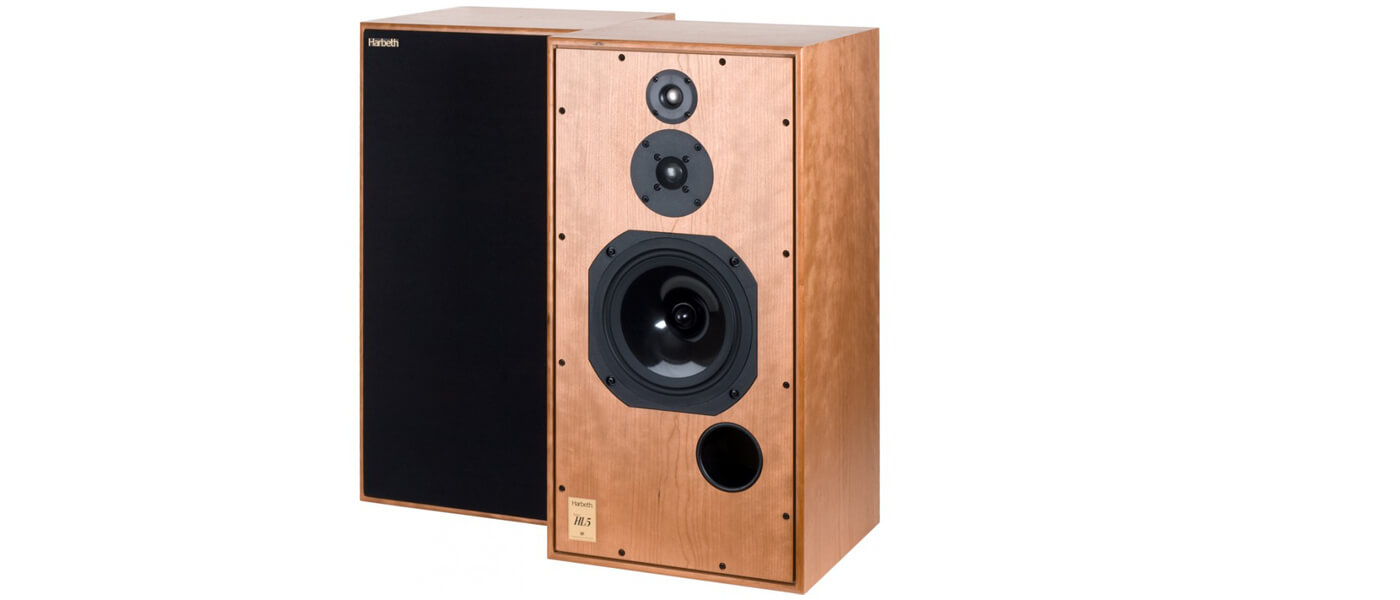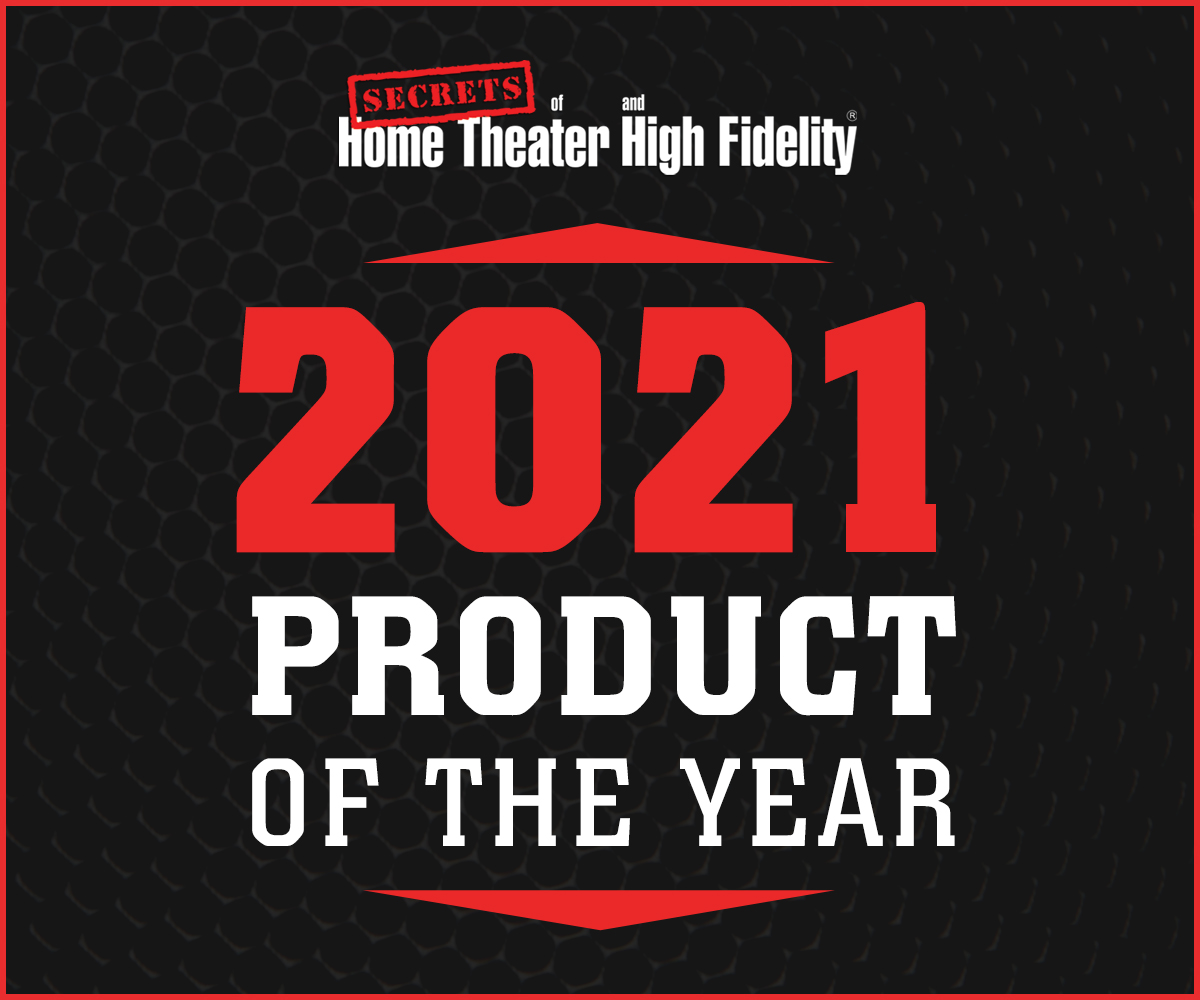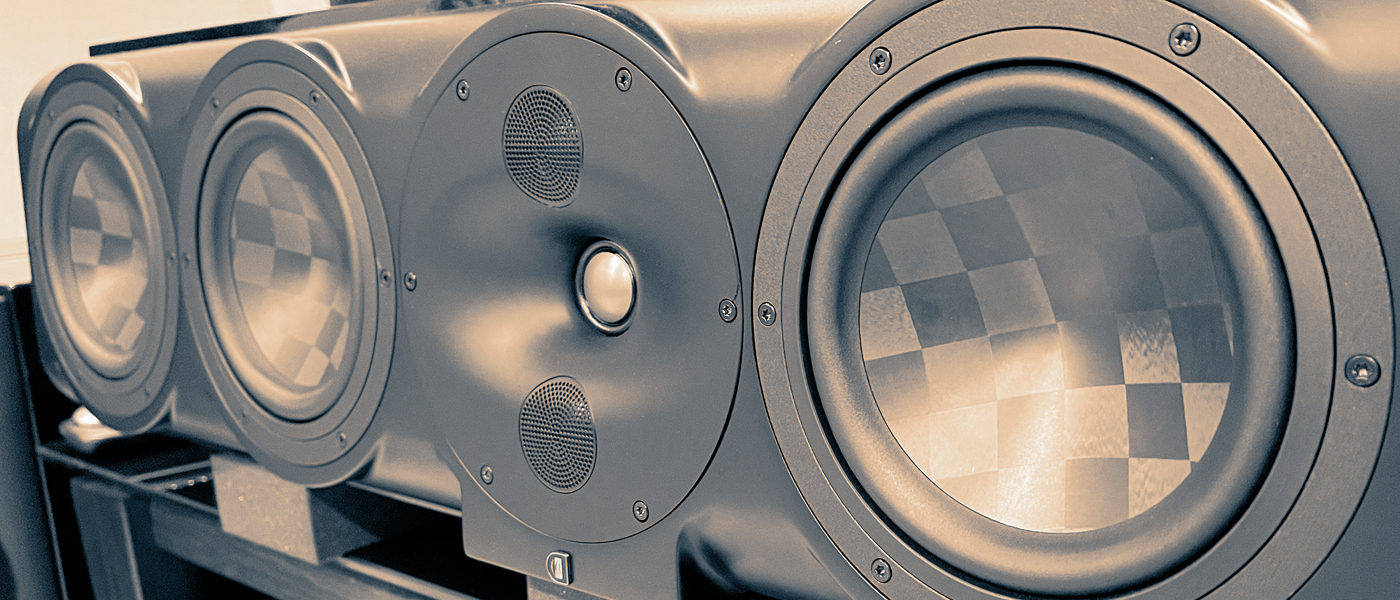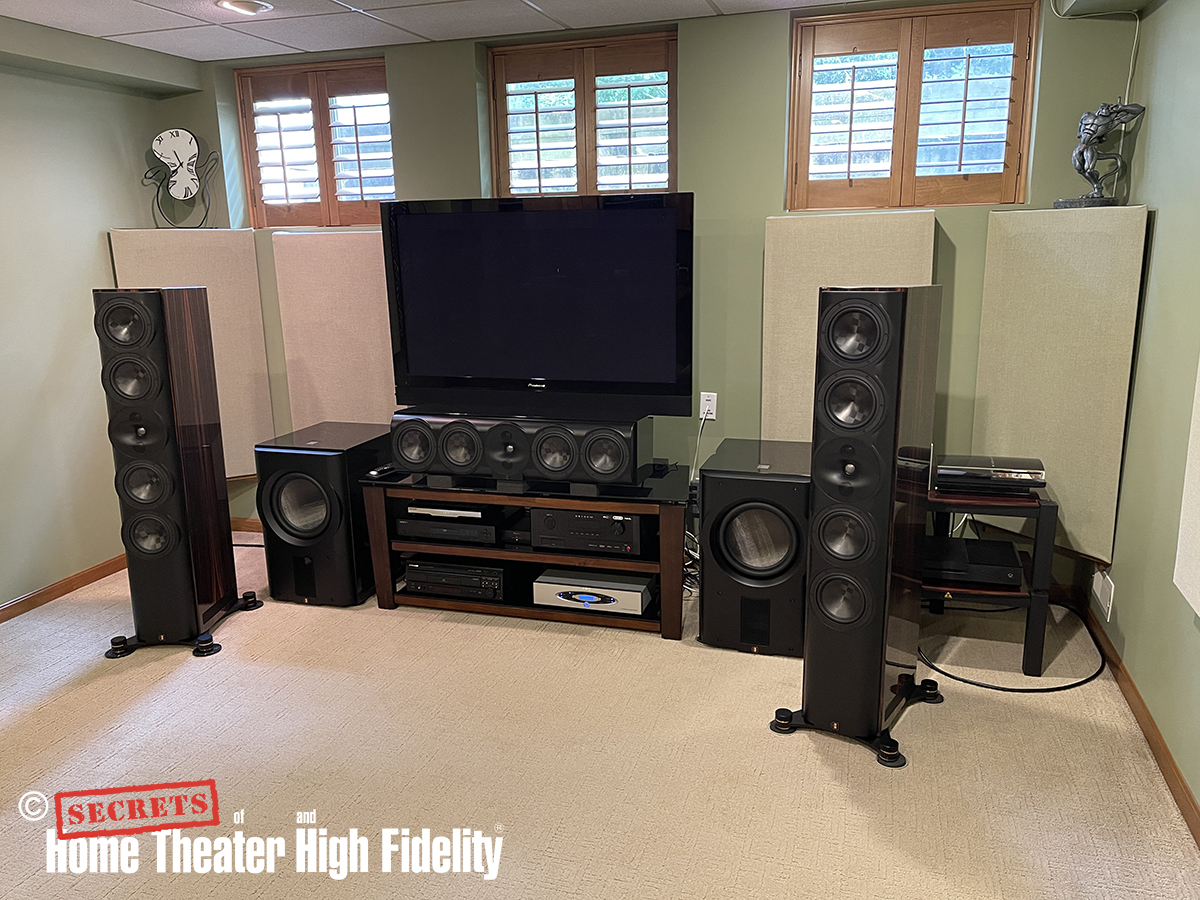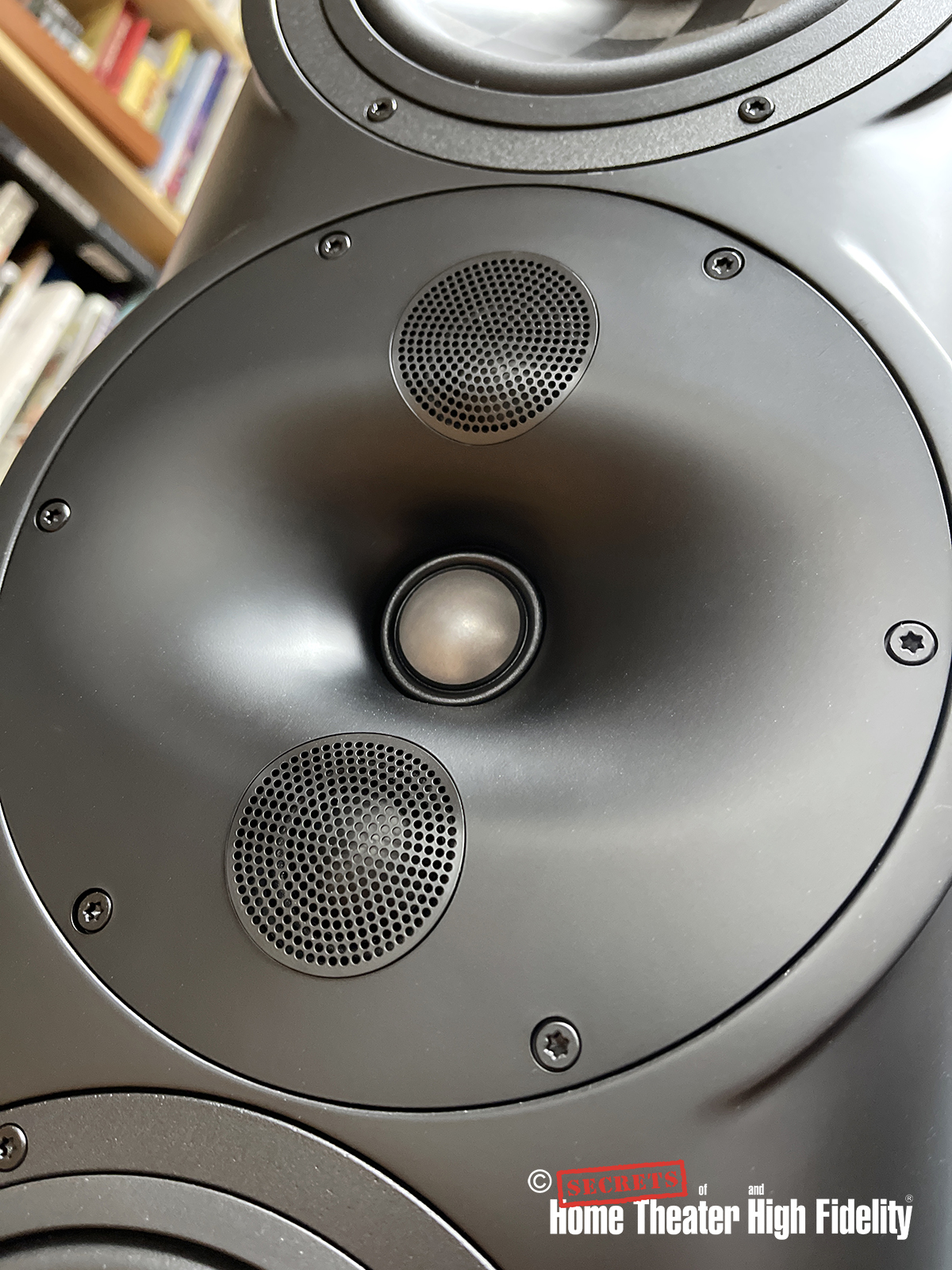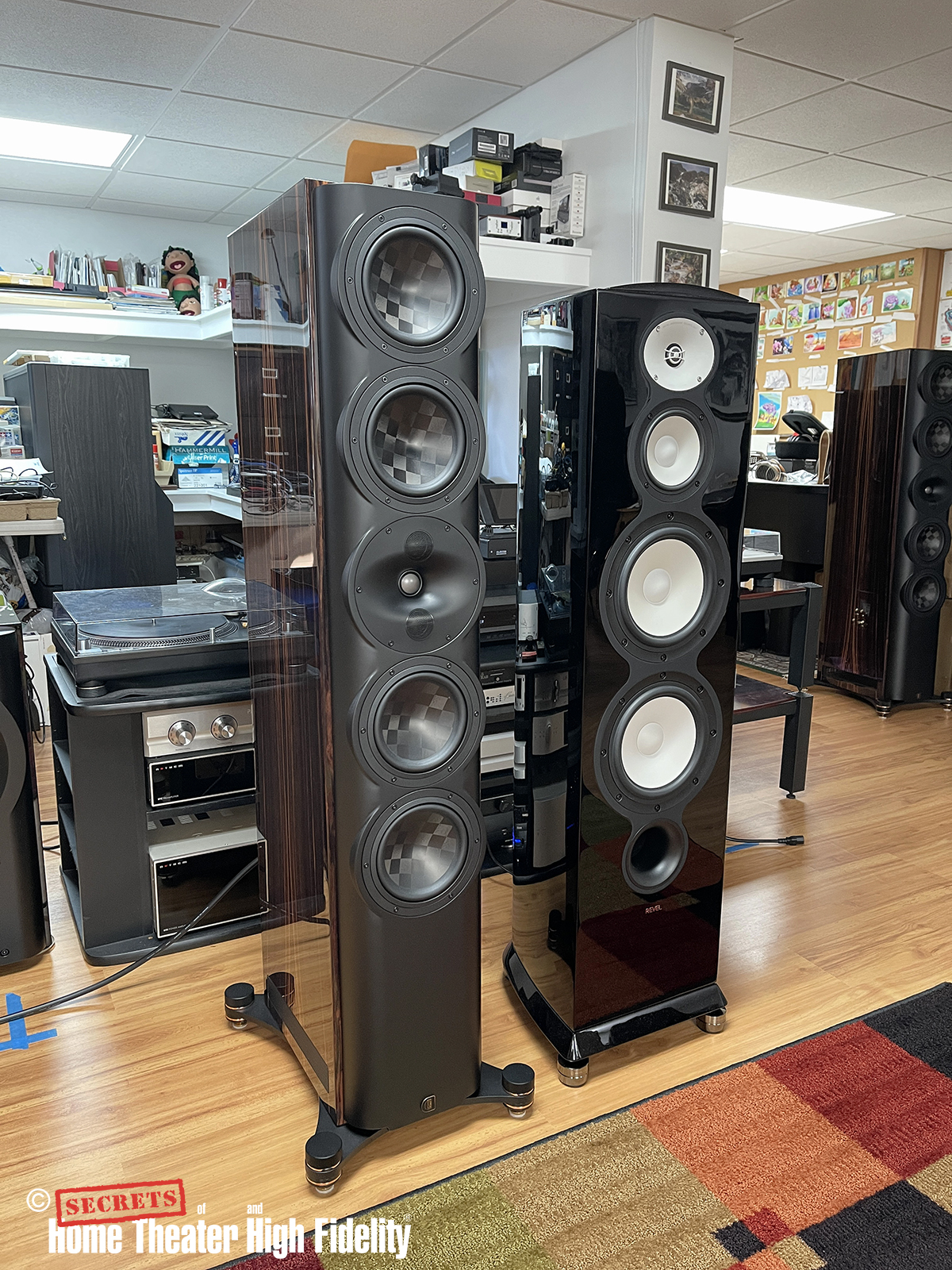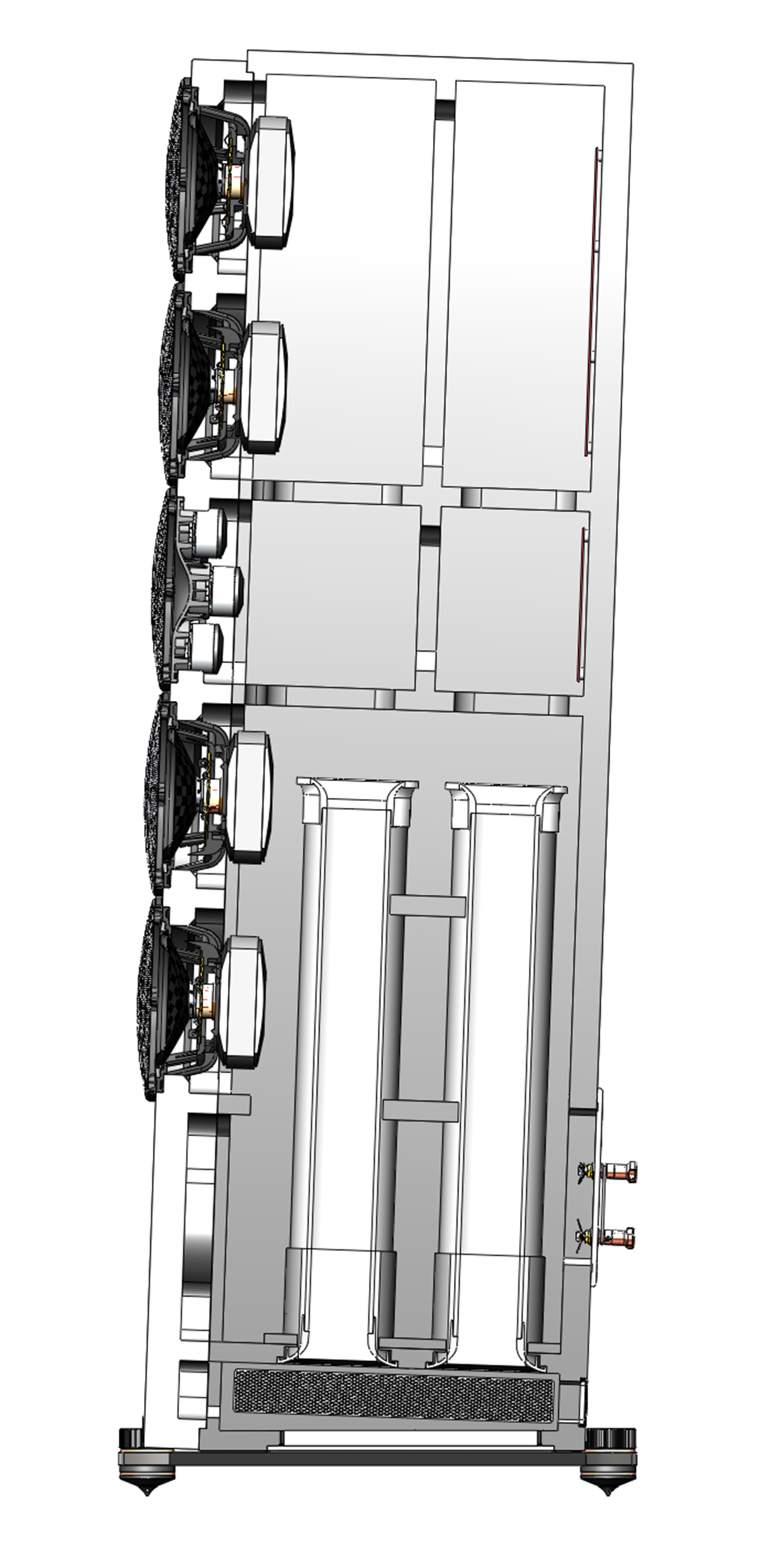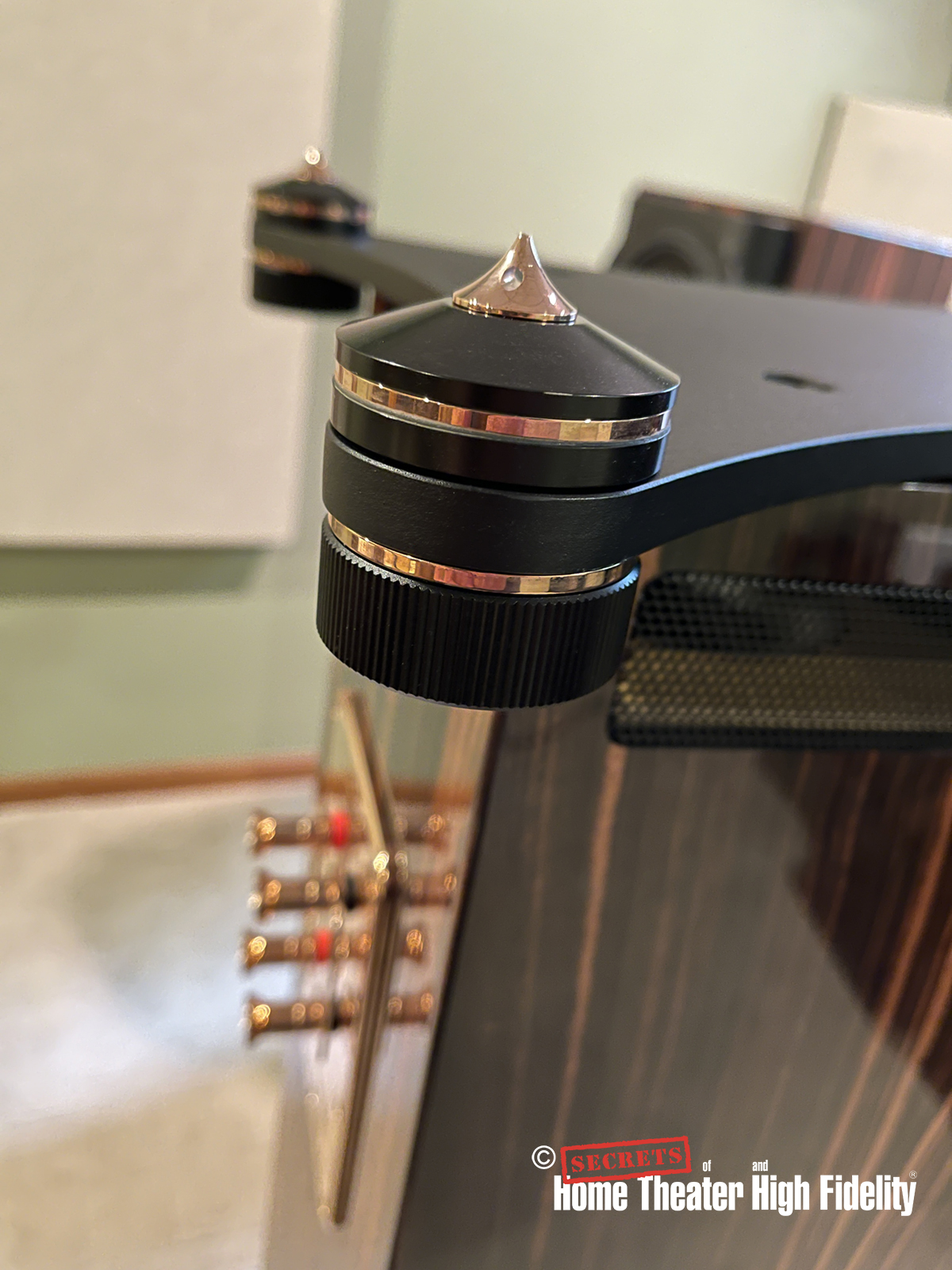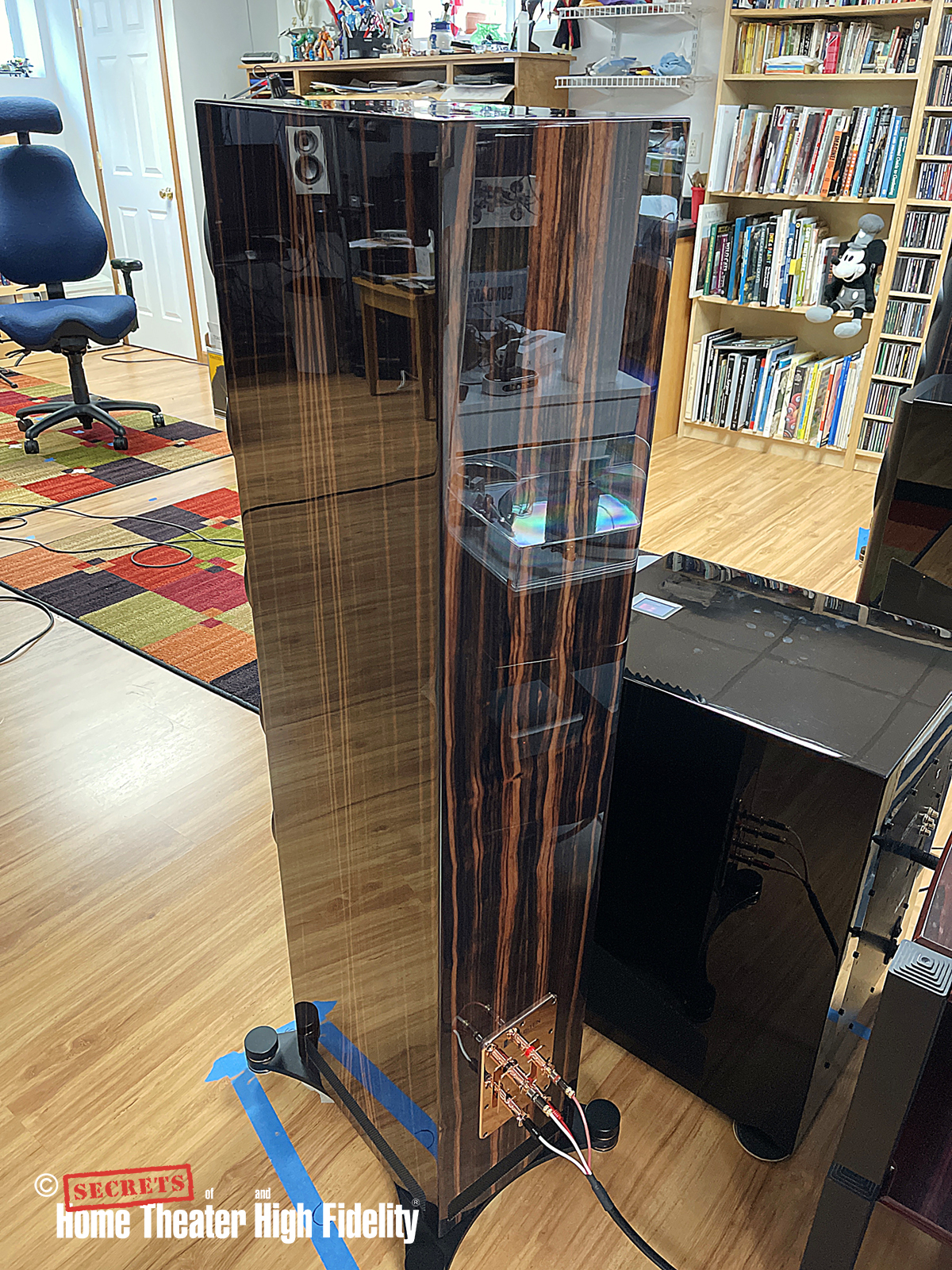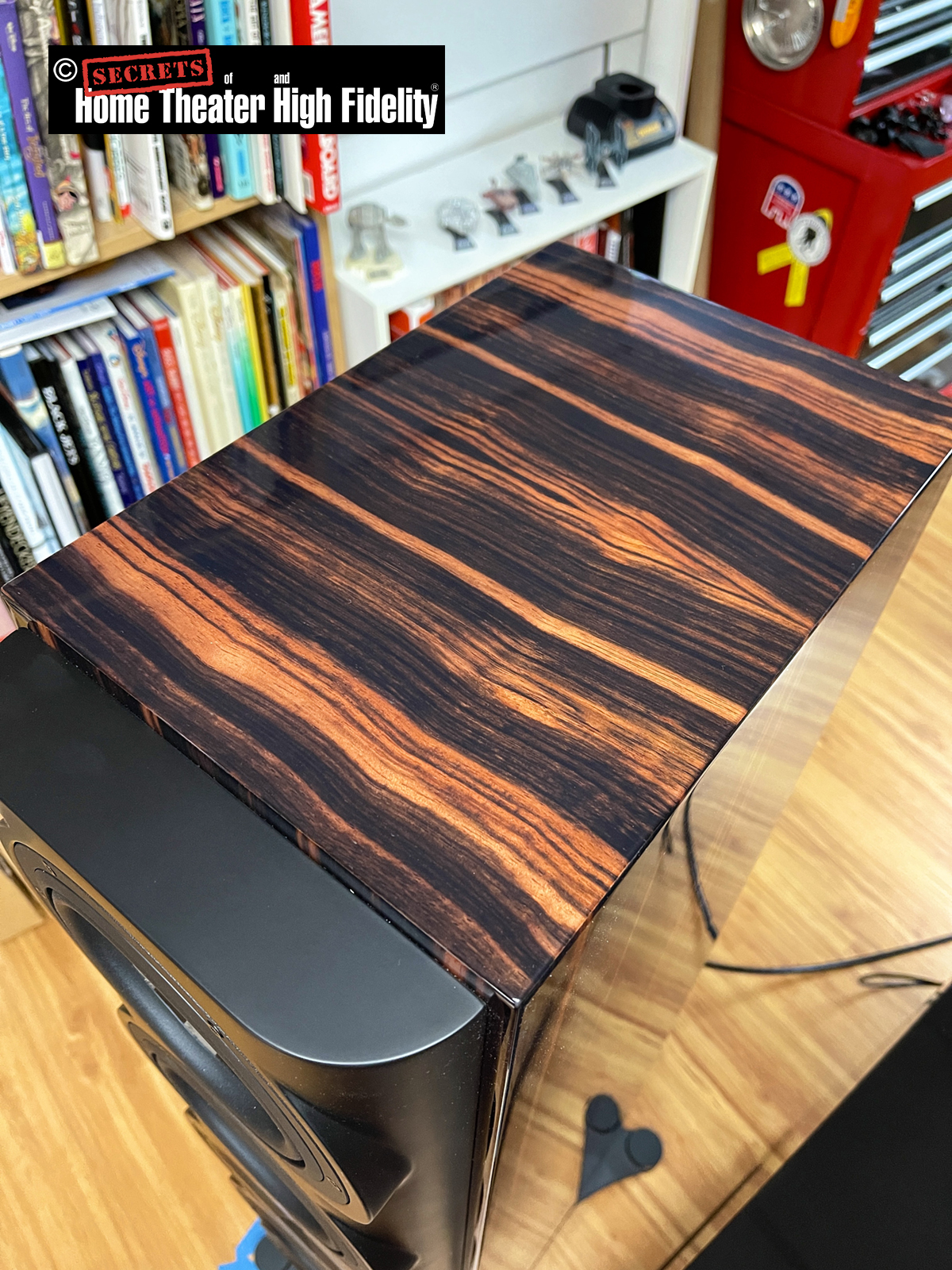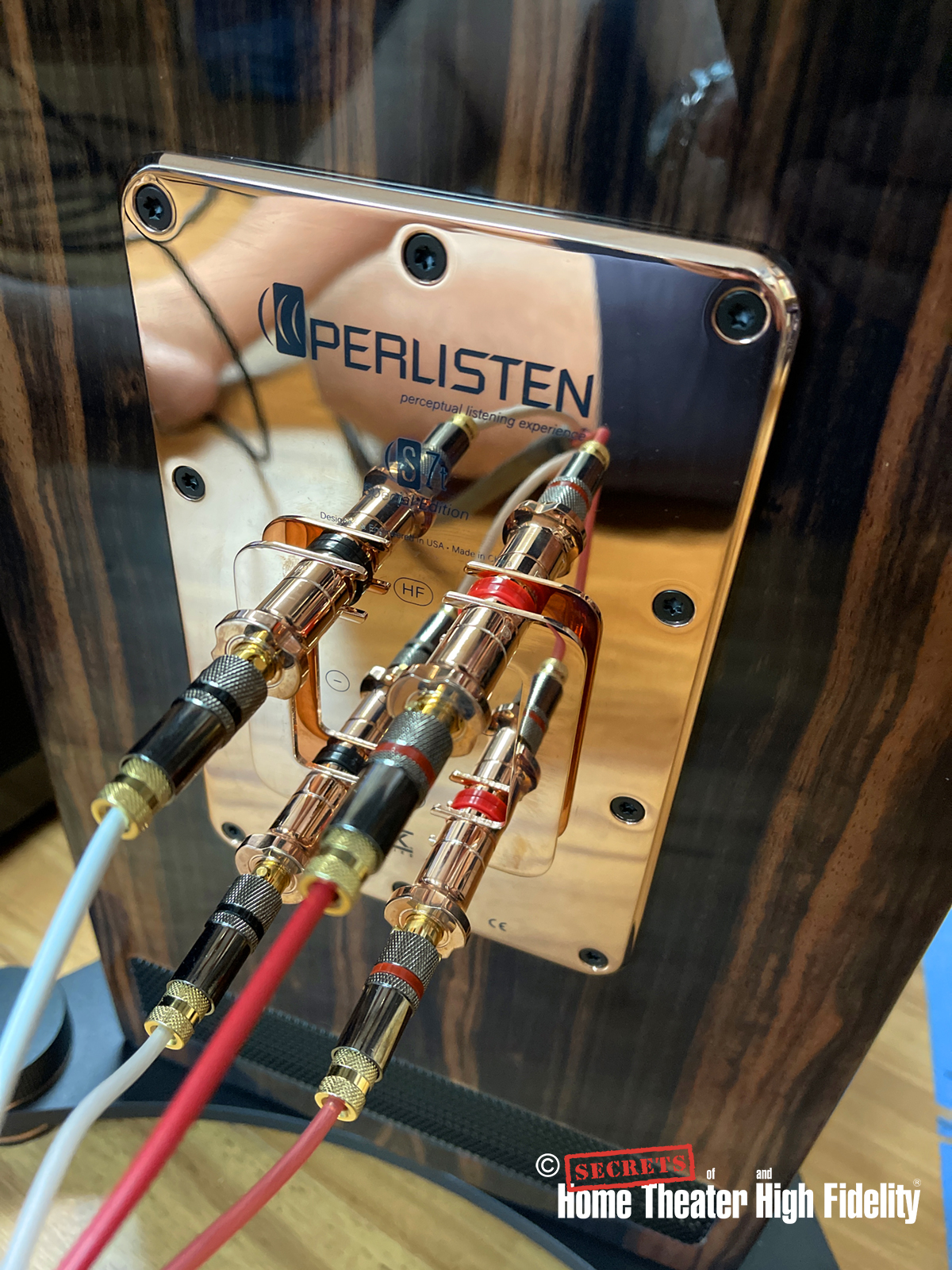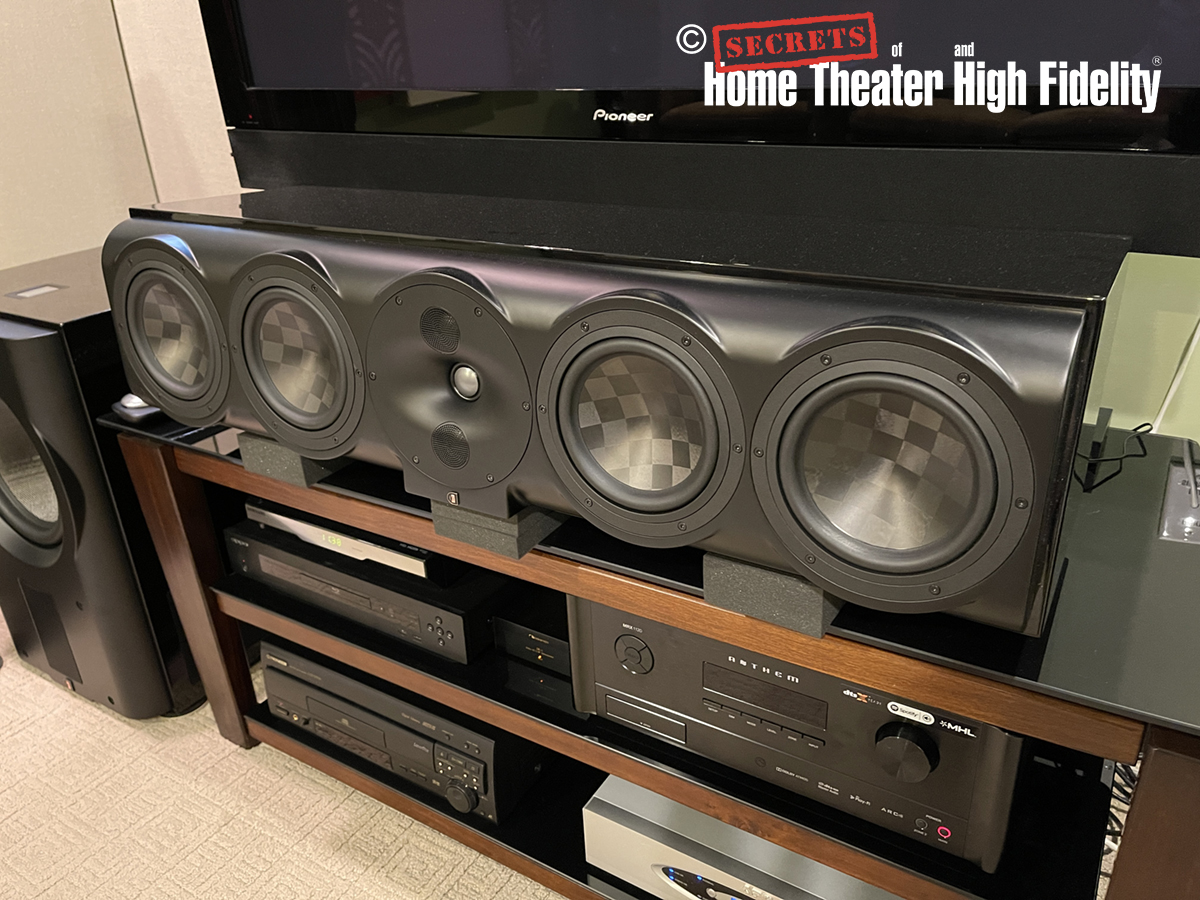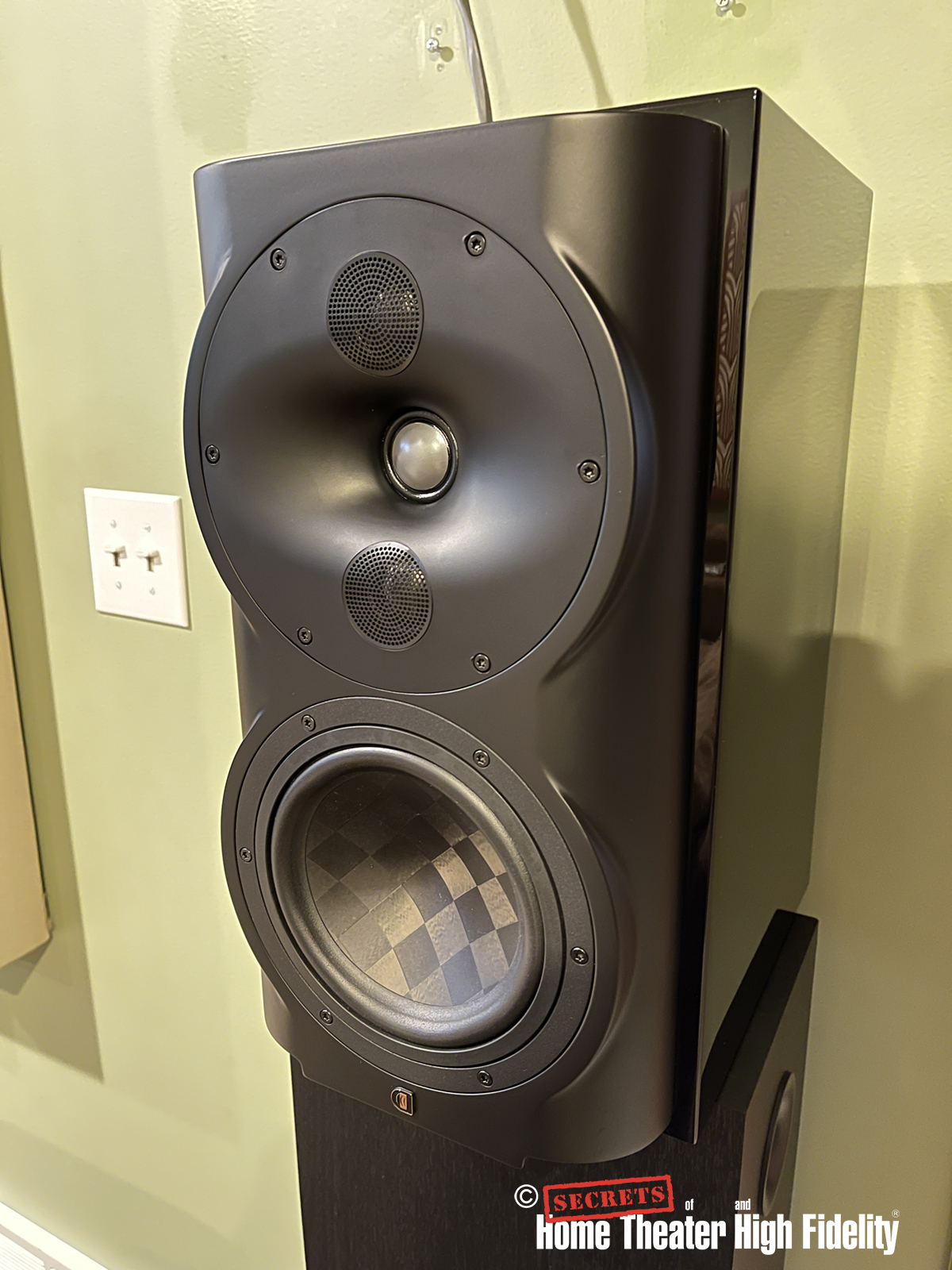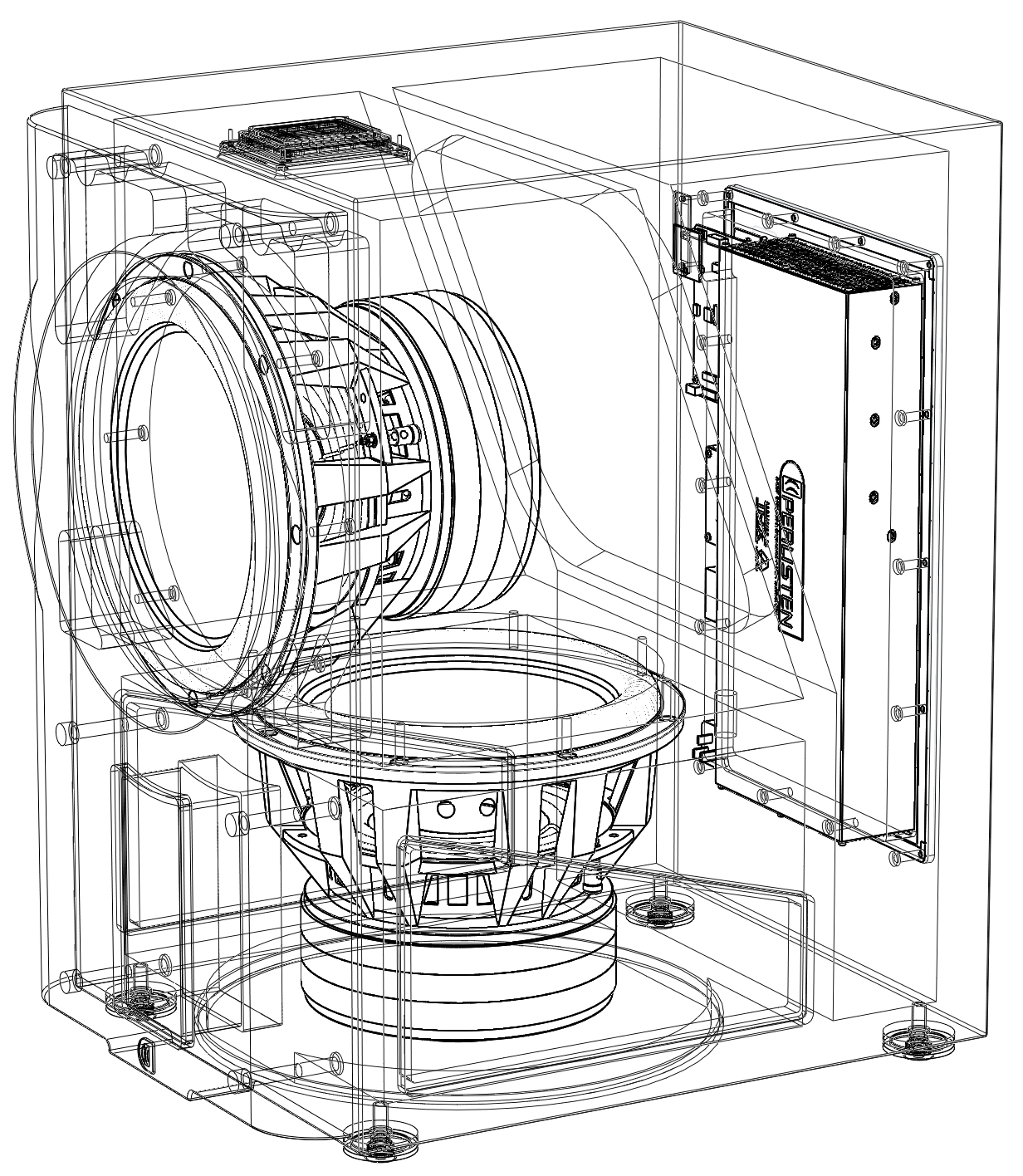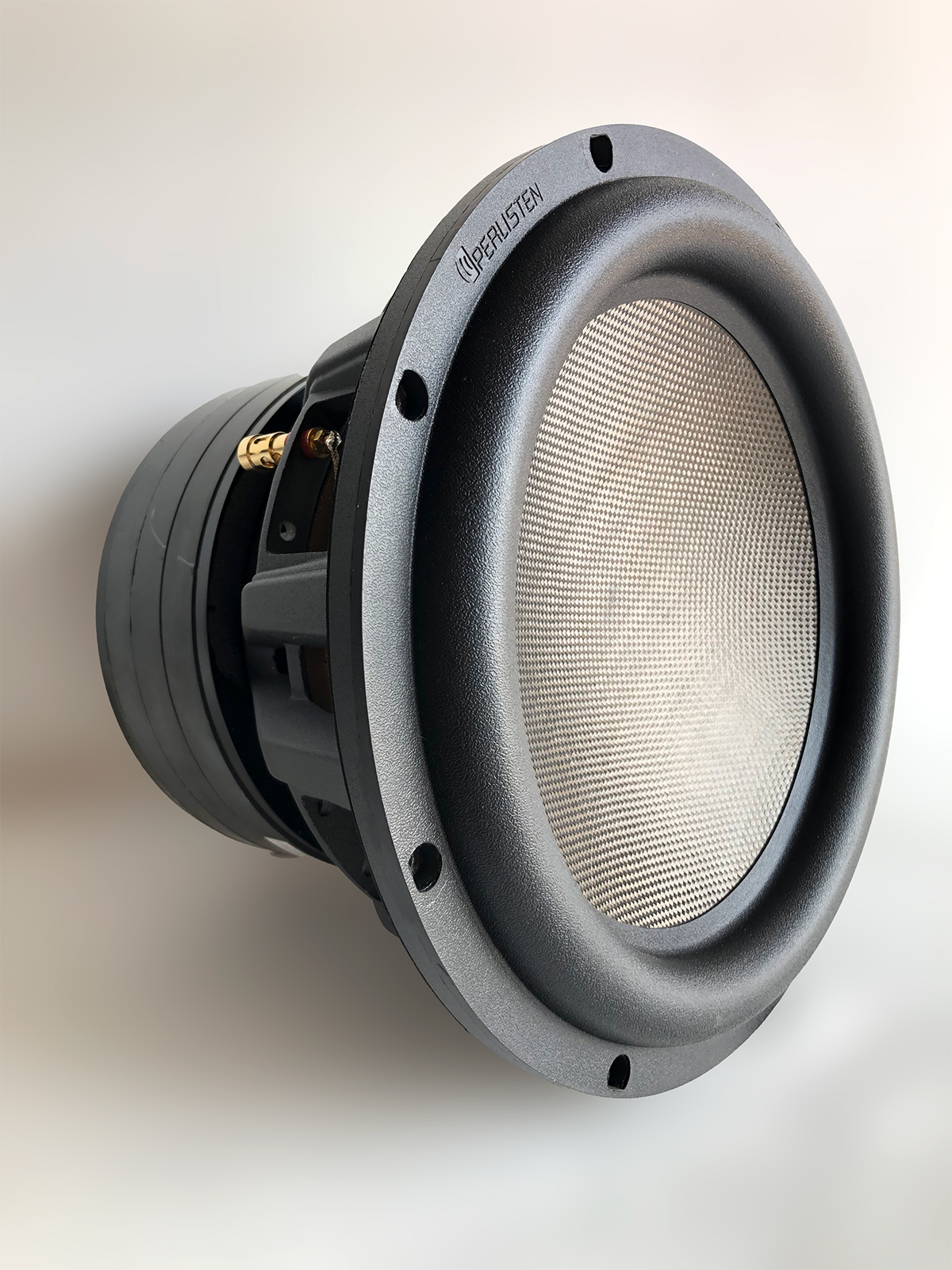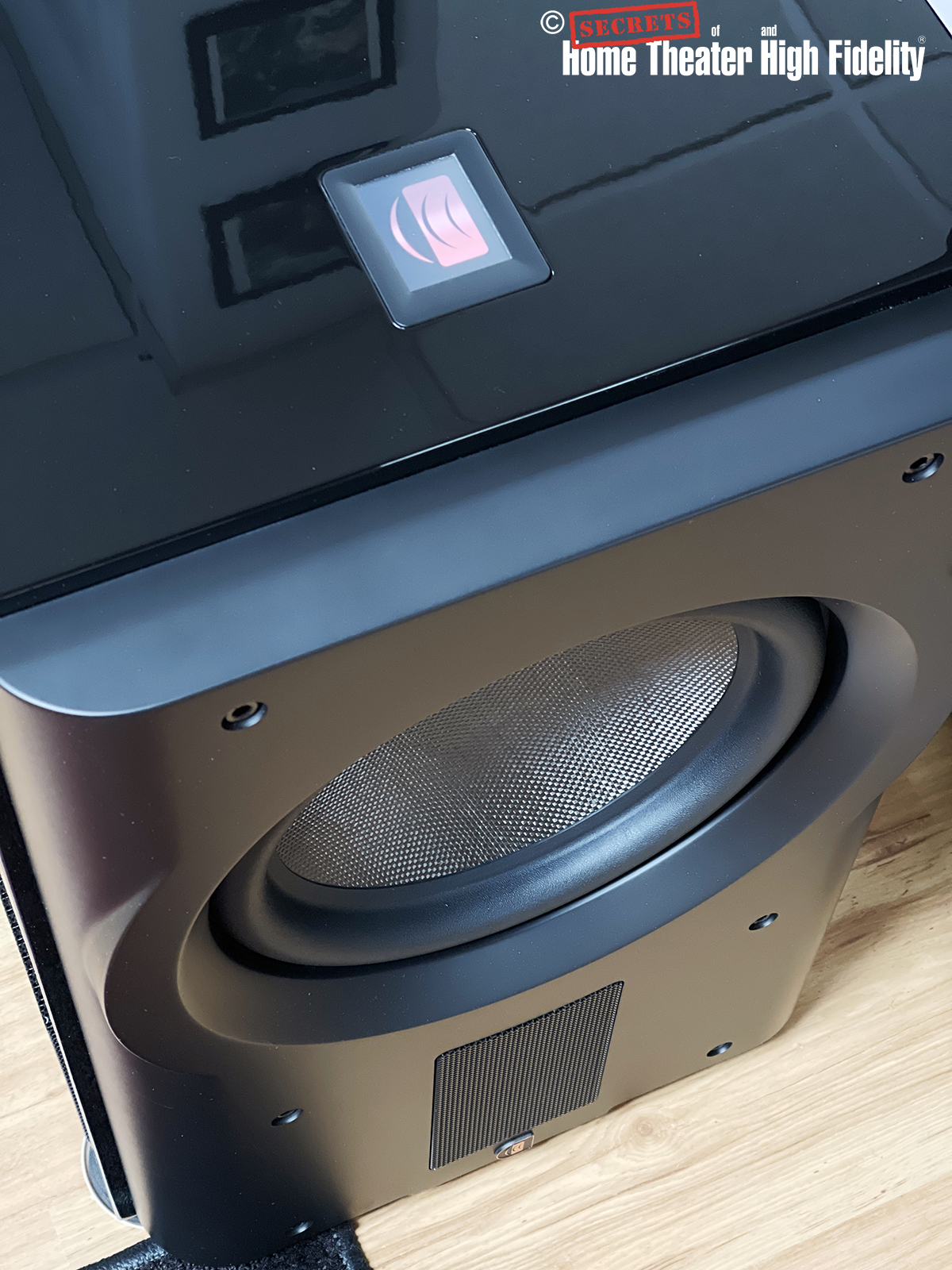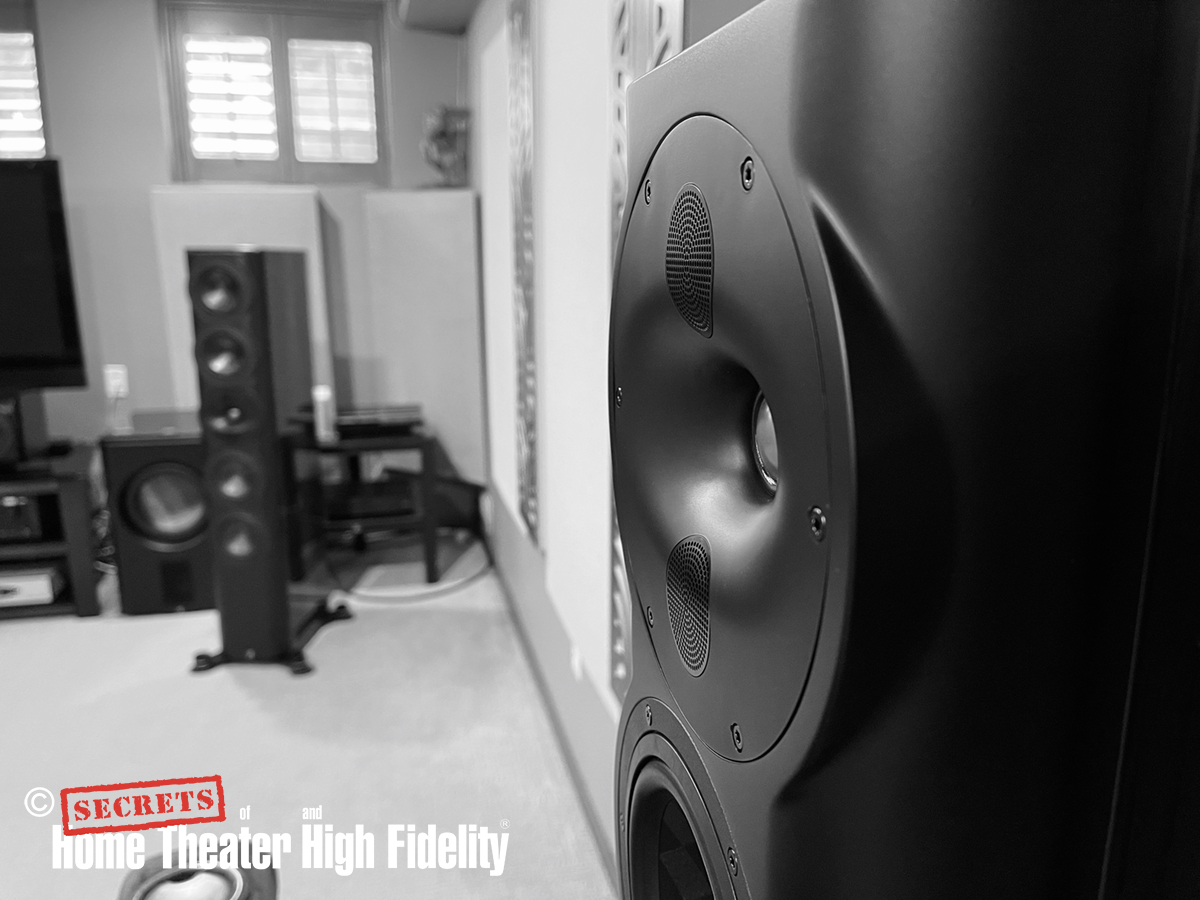The company is looking to make a statement with its products, and after spending some time with this review system, l can unequivocally say that Perlisten has succeeded. Big time!
As I said, Perlisten Audio wanted to make a statement as they presented themselves to the world this year and they did not mess around. Perlisten introduced some distinctly top-shelf products that are squarely targeted to compete against the best currently out there. The company sent me a complete 5.2 channel home theater system to review. The product information sheets pointed to some serious technical innovations in these speakers and subs, along with being the first set of speakers to meet the requirements of a newly introduced THX specification with the menacing name of “Dominus.”
Perlisten Audio 5.2 Channel Home Theater System
- All speakers use a proprietary midrange and high-frequency array centered within a custom waveguide.
- Array results in some of the best vertical dispersion characteristics that I have encountered. Very much like beamforming technology but without DSP.
- Woofer driver cones are made from a multi-layered carbon fiber. Very light and very strong.
- Some of the heaviest and most overbuilt speakers I’ve seen (or lifted).
- The subwoofers use dual 12-inch drivers in an uncommon push/pull configuration with a massive amplifier to deliver incredible impact with low distortion.
- The custom subwoofer app is extremely well designed and offers a ton of control.
- THX Certified Dominus specification certifies that speakers meet extreme SPL and ultra-low distortion targets in rooms up to 6500-cubic feet with up to a 20-foot viewing distance.
- Some of the best, most dynamic, yet cohesive sound that I have experienced in my home theater.
- The custom High-gloss ebony finish of the S7t towers was just drop-dead gorgeous!
Having done this job for going on 8 years now, I’ve gotten to learn about and experience a lot of diverse and interesting audio products here at Secrets. Plenty of these items come to my attention claiming to be “the next big thing, advancement, revolution, or whatever in sound.” But once you clear through all the marketing hyperbole and you take a good hard look, and listen, things tend to come a little more down to earth. My experience has been thus far, I find a lot of very good products, some that are not so good (we intentionally try not to waste our time with these because time is precious), and just a few exceptional items or even true surprises. We often see these sorts of “elevated” performance claims from brand new companies that come to market plying their wares and looking for press. Often, it’s a simple affair to spot the poseurs with high-end aspirations that end up being little more than flowery copy on a press release. Occasionally though, a genuinely unique and interesting take on, say a speaker or an amplifier or some other audio technology will come along that merits further investigation.
Such was the case when I was introduced to an upstart company called Perlisten Audio. While they are a new brand in the market, the 2 principal gentlemen behind the company each have a long history and plenty of combined engineering and marketing experience in audio, which is a good thing to get a venture like this up and running. I also discovered that, because of said history and experience, these guys own/control most of their production chain so they aren’t designing this stuff and farming it out to a contract factory. They are building it themselves at their own facilities and are exercising stringent QC throughout the process. After attending a video conference and speaking with Perlisten CEO Dan Roemer, CSO Lars Johansen, and some of their engineering team, it became very clear that this was a substantive operation with real engineering and innovation on their minds. Yes, they were having fun making a bit of a splash with the whole THX Certified Dominus specification (which I will get into later), but if nothing else, they were deadly serious about the speakers and subs they were launching and the technology briefing they gave put not too fine a point on it.
So, in short order, I found myself in the possession of a 5.2 channel Perlisten home theater system consisting of a pair of S7t tower speakers, an S7c center channel speaker, a pair of S4b bookshelf speakers, and two D212s subwoofers. Potentially one of the most potent surround systems that I have yet reviewed. And beyond simply exploring the entire system in my home theater as initially intended, I wanted to also spend some quality time with the S7t towers in my studio two-channel system. I wanted to hear how some of the applied technology in these speakers sounded with simple stereo music along with running some bench tests on them there to evaluate their technical performance. Things were about to get very interesting!
S7t Tower Speaker
Description:
4-way bass-reflex/acoustic suspension floor-standing loudspeaker with down-firing ports.
Low-Frequency Driver:
Quad 180 mm Textreme (Carbon Fiber) bass drivers.
Frequency Response (-10 dB):
Bass reflex (ported): 22 Hz-37 kHz (Manufacturer).
Acoustic suspension (sealed): 32 Hz-37 kHz (Manufacturer).
Crossover Frequencies:
500 Hz, 1.1 kHz, 4.4 kHz.
Nominal Impedance:
4Ω nominal/3.2 Ω m.
Sensitivity:
92 dB (2.83 Volts @ 1 Meter).
Recommended Amplifier Power:
100-600W RMS.
Available Finishes:
Piano Black, Piano White, Natural Cherry, Natural Black Cherry, Natural Ebony, High Gloss Ebony, Custom Painted Finishes based on PANTONE© color swatch.
Dimensions (H x W x D):
51.0 x 9.5 x 15.7” (1295mm x 240mm x 400mm).
Net weight:
55.7 kg (122.5 lbs.)
MSRP:
$15,990/pair (standard finish); $17,990/pair (special edition finish).
S7c Center Channel Speaker
Description:
4-way Acoustic suspension loudspeaker.
High and Mid-Frequency Drivers:
Single 28 mm Beryllium dome and Dual 28 mm Textreme (Carbon Fiber) domes integrated with a custom waveguide.
Low-Frequency Driver:
Quad 180 mm Textreme (Carbon Fiber) bass drivers.
Frequency Response:
(-10 dB): Acoustic suspension (sealed): 38 Hz-37 kHz (Manufacturer).
Crossover Frequencies:
500 Hz, 1.1 kHz, 4.4 kHz.
Nominal Impedance:
4Ω nominal/3.2 Ω min.
Sensitivity:
92 dB (2.83 Volts @ 1 Meter).
Recommended Amplifier Power:
100-600W RMS.
Available Finishes:
Piano Black, Piano White, Natural Cherry, Natural Black Cherry, Natural Ebony, High Gloss Ebony, Custom Painted Finishes based on PANTONE© color swatch.
Dimensions (H x W x D):
37.8 x 9.5 x 15.7″ (960 x 240 x 400mm).
Net weight:
33.5 kg (74 lbs.)
MSRP:
$6,995/each (standard finish); $7,995/each (special edition finish).
S4b Bookshelf Speaker
Description:
3-way Acoustic suspension loudspeaker.
High and Mid-Frequency Drivers:
Single 28 mm Beryllium dome and Dual 28 mm Textreme (Carbon Fiber) domes integrated with a custom waveguide.
Low-Frequency Driver:
Single 180 mm Textreme (Carbon Fiber) bass drivers.
Frequency Response (-10 dB):
Acoustic suspension (sealed): 36 Hz-37 kHz (Manufacturer).
Crossover Frequencies:
1.25 kHz, 4.4 kHz.
Nominal Impedance:
4Ω nominal/3.2 Ω min.
Sensitivity:
85.4 dB (2.83 Volts @ 1 Meter).
Recommended Amplifier Power:
50 – 300W RMS.
Available Finishes:
Piano Black, Piano White, Natural Cherry, Natural Black Cherry, Natural Ebony, High Gloss Ebony, Custom Painted Finishes based on PANTONE© color swatch.
Dimensions (H x W x D):
16.5 x 9.5 x 7.3″ (420 x 240 x 185mm).
Net weight:
11.0 kg (24.2 lbs.)
MSRP:
$3,495/each (standard finish); $3,995/each (special edition finish).
D212s Subwoofer
Description:
Push-Pull, acoustic suspension subwoofer
Driver Compliment:
Dual 380mm High Excursion Bass Drivers with Carbon fiber diaphragms.
Frequency Response (Manufacturer):
THX EQ – 20 – 200 Hz (-6dB) / 16 – 210 Hz (-10dB)
Boost (Large Room) EQ – 15 – 200 Hz (-6dB) / 13 – 210 Hz (-10dB)
Cut (Small Room) EQ – 24 – 200 Hz (-6dB) / 18 – 210 Hz (-10dB)
Amplifier:
3kW RMS Short Term.
Control Interface:
2.4″ LCD color touchscreen on unit and iOS or Android Smartphone App.
Sensitivity:
92 dB (150 mVolts @ 1 Meter).
Inputs:
(2) Balanced XLR, (2) Unbalanced RCA.
Outputs:
(2) Balanced XLR, unbuffered, (2) Unbalanced RCA, unbuffered.
Parametric EQ:
10-Band PEQ with 3 user presets.
Phase:
Variable 0 – 270 Degrees.
Low Pass Filter:
Bypass, 30 – 160 Hz, slope 6, 12, 18, 24dB/oct.
Available Finishes:
Piano black.
Dimensions (H x W x D):
31.7 x 19.7 x 25.6″ (805 x 500 x 650.5mm).
Net weight:
68.0 kg (149.6 lbs.)
MSRP:
$6,995/each.
Website:
Company:
SECRETS Tags:
perlisten, tower, speakers, floor standing, beryllium, dpc, array, surround, home theater, Home Theater Review 2021
So, what separates these Perlisten audio speakers from other designs that compete on the same level? Quite a bit, but since we have three separate models here that make up this home theater package, I will address the technical and driver points that are common to all the speakers first before drilling down into more individual detail. The D212s subwoofer is a whole other animal whose description will be broken out separately.
The first thing that grabs your attention about the S7t towers, S7c center channel, and S4b bookshelves when you first lay eyes on them is the cycloptic central waveguide. At first blush, it looks like it has a vertical array of three tweeters but that is not quite right. The main dome nestled inside the throat of the waveguide is a 28mm (1.1-inch) Beryllium tweeter that has an operating range from 1 kHz to over 30 kHz. The two other domes (also 28mm each) that vertically flank the central tweeter are made from a thin-ply carbon fiber (called TPCD or Textreme) and operate together acting as a midrange driver. These “midrange domes” operate from 1 kHz to 4 kHz and are mounted precisely, ahead of the tweeter, on the upper and lower apex of the waveguide mouth and are behind specially designed screens. Perlisten calls this triple driver/waveguide hub a Directivity Pattern Control-Array (DPC). As the name implies, the Directivity Pattern Control modifies the speaker’s radiation patterns, specifically in the case of the Perlisten the vertical radiation pattern. As we will see when we get to the measurement section, the vertical radiation pattern is like no other speaker, and it significantly attenuates ceiling and floor reflections. For most rooms, those are far more critical than the wall reflections. You cannot put deep absorbers on the floor at reflection points. You can do it on the ceiling, but your place is going to look strange unless you are doing an expensive custom room design and build.
Since the floor and ceiling bounce is shorter from the speakers to your ears than the wall bounce in most rooms, the bounce is shorter in distance and thus it is higher in amplitude than the wall bounces. Larger to start with and hard to attenuate without making your room look like a science project requires another solution. That is what Perlisten provides. Make the energy in the vertical direction exiting from the speaker, which excites the floor and ceiling, smaller. Easy to say but it’s hard to make it work. Perlisten says they have several patents pending on the design.
The 7-inch checkerboard-patterned bass drivers (four on the towers and center channel and one on the bookshelf speakers) use multiple layers of the same TPCD material for their cones as the midrange domes use. Very light but incredibly rigid, the checked pattern on the driver cones is not some design affectation but it’s the actual layered weave of the material. On the S7t tower and S7c center channel speakers, the inner pair of drivers operate from 22 Hz to 1.35 kHz while the outer pair work from 22 Hz to 550 Hz. Designing the speaker to significantly attenuate the wall and ceiling reflections requires not only changes in the driver’s physical placement, but significant innovations in the crossover. Not all the drivers operate at the same amplitude or phase angle and the spacing and orientation of each driver (including depth) must be very precise, and the crossover must manage all that.
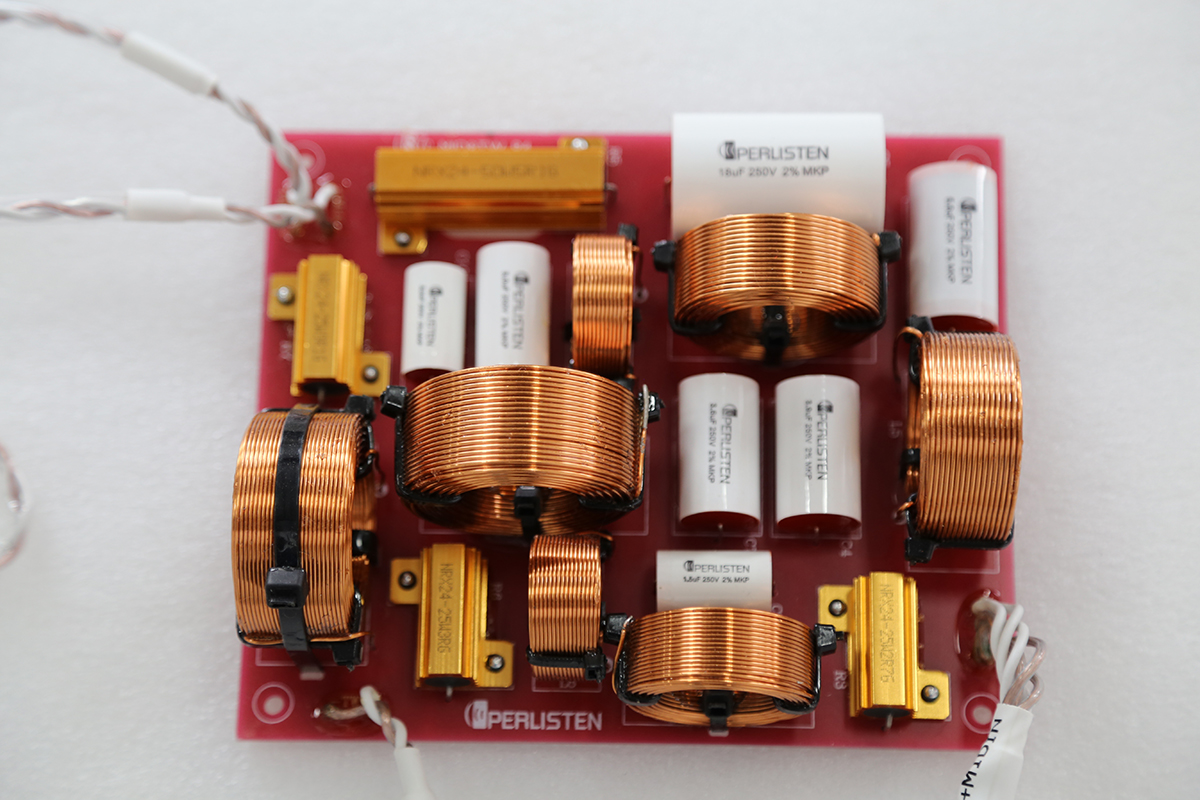
Perlisten S7t, Midrange/Tweeter Crossover Board

Perlisten S7t, Bass Driver Crossover Board
You can see the two crossover boards, one for the bass drivers another for the midrange and tweeter section, are necessarily complex to conduct all the elements correctly. As we mentioned above, the speaker needs a different crossover design so the drivers can interact to control the floor and ceiling bounces. The design of the crossover is only possible using custom speaker design optimization tools. The problem you get into when you move away from traditional high-order crossovers is the sensitivity of the final design’s performance to a small change in crossover component values. Perlisten uses 2% components. Do not try and order them from your friendly parts distributor. The capacitors are custom tested 5% units with the parts out of the desired spec rejected. Inductors are custom wound to meet the tight spec.
David Rich Notes: As can be seen, Perlisten has gone with all air-core inductors and film capacitors even in the woofer crossover. That is expensive for any speaker, but these complex crossovers are using more components than a speaker designed to produce an acoustic 4th order crossover response. These expensive film caps and air-core inductors are expected in speakers at this price range, but the good news is Perlisten is working on less expensive designs (R-series) that do not use so many pricey crossover parts. The tight tolerance requirements and a larger number of required passive components are not something they can make go away in this S-series design approach.
Narrowing in on the individual speakers now, the Perlisten S7t tower, while aesthetically impressive, isn’t overly imposing in either size or footprint, being just slightly taller than my Revel F228Be speakers, and having a gentle rearward rake when viewed in profile. The tilt of the speaker is to optimize the frequency response at seated ear level. The main enclosure is built with 0.75-inch and 1-inch High-Density Fiberboard (HDF) with extensive horizontal and vertical bracing, along with being lined with additional damping materials. The front baffle is made from a solid HDF block that has been carved to the desired shapely result to house the drivers just so. The whole shebang sits on a curvy but heavy steel plinth with 4 substantial feet with polished rose gold spikes. Rest easy that at 122 lbs. per tower the S7t cabinets are properly inert and, once you place them, they aren’t going anywhere. These were some of the heaviest loudspeakers that my son and I had to navigate down the stairs and into our basement HT. The speakers also have two internal 3.5-inch down-firing ports with the air emptying through the rectangular mesh openings, all around the base. Perlisten includes foam plugs to stuff the ports and change the S7t to a sealed tuning but installing them requires turning the speakers on their side (or upside down) and removing both the plinth and another metal plate to access the ports. Plugging the ports would be something you could (some would say should) do when integrating these speakers with subwoofers to help achieve a better blend. Being as heavy as they are, I recommend using two people to successfully, and safely, achieve this task.
The S7t towers are available in a variety of standard and custom finishes, and while the website images mentally prepared me for an all-black look, my review samples arrived in a stunning high gloss ebony wood finish that just wowed everyone who laid eyes on them. In the back, two sets of substantial speaker terminals, with jumpers, are set onto an equally substantial terminal plate, all are finished in the same highly polished rose gold of the speaker spikes. Unlike some other tower speakers where the tweeter is typically found towards the top of the cabinet, the S7t has its DPC Array set in the middle of the box, flanked by the woofers above and below. Perlisten claims that this orientation allows the speaker’s output to sum sooner so the towers can be properly enjoyed even in smaller rooms when listening at closer distances.
Consider the S7c center channel speaker to be a sealed box version of the S7t tower, just turned on its side with the DPC Array rotated by 90-degrees and no plinth. All the same innovative design, heavy-duty build quality, and back-breaking weight observations that applied to the towers, apply to the center channel as well. The review sample was finished in a lustrous high-gloss black with chromed silver binding posts and terminal plate.
The S4b bookshelf speaker that will be used for surround duty is a sealed compact monitor that is heavier and more inert (think lead brick) than any other comparably sized speaker that I’ve come across. It uses the same DPC-Array and a single 7-inch TPCD woofer as found in the larger S series models. It was also finished in the same piano black look as the center channel. The S4b has a set of mounting holes on the back that work with a custom bracket allowing for wall mounting. I should note that Perlisten also makes the S4s on-wall surround speaker that looks like an upside-down and shallower S4b with a downward angled baffle. It’s designed to be flush mounted to the wall and would have been perfect for my theater room, but all the early production samples had been spoken for by dealers. No matter, I was able to work with the bookshelf just fine for this review.
As would be fitting, none of these Perlisten speakers use conventional grilles. All the speakers came with the appropriate number of perforated 7.5-inch metal rounds that magnetically attached over each driver and the DPC Array. I liked the look of the speakers with the grille rounds on. It’s unique and one of the few examples of a speaker grille that flatters the design. The speakers still look cooler with them off but it’s nice to have them available should you have young ones around with wayward hands.
And finally, we get to the D212s subwoofers. I am always grateful when manufacturers entertain my request for dual subwoofers to use for home theater system reviews. For some reason though, I was under the assumption that Perlisten was sending a pair of their smaller single driver subwoofers for me to play with. I began to seriously re-evaluate my sanity when the palette carrying the dual D212s was wheeled off the delivery truck and into my garage. The D212s don’t have an unreasonable footprint for a sub by any stretch, but each one houses two massive, custom made 12-inch bass drivers in a push-pull configuration and if you factor in the same level of build and bracing as I’ve outlined in the other speakers, you’ll understand how each one of these guys tips the scales at almost 150 lbs. How we ever got these two subs into our basement without breaking them or ourselves I’ll never know, but we did it!
Perlisten claims that having two drivers (one oriented perpendicular to the other and with inverted polarity) sharing the same common air volume results in a 10 dB reduction in even-order harmonics. The drivers themselves were completely designed by Perlisten to have a high sensitivity, low mass, low inductance, low distortion with a very long linear motion. Perlisten states that these drivers have a 60 mm peak-to-peak length of linear travel. The diaphragm uses a carbon fiber construction for a lightweight yet rigid moving surface that is motivated by a huge magnet structure. The drivers are powered by a sizeable Class-D amplifier capable of outputting up to 3 kW of power for short-term bursts. This is all monitored and controlled by sophisticated DSP and accessible by both a small touch screen on the top of each sub for basic settings and an iOS or Android smartphone app for much more granular control. I used the iOS app on my iPhone and found it to be smartly laid out with complete access to both individual subs and global volume as well. There was access to features like 3 different preset subwoofer tunings depending on room size, 10 bands of Parametric EQ with 3 different memories, independent Trim and Crossover settings along with RCA or XLR input control with adjustable gain for each. During my review, the app also advised me of a firmware update for the subs and it easily updated the code on each unit via Bluetooth.
A word on the THX Certified Dominus specification. A few years back THX decided to revamp and broaden their certification levels that categorized home theater equipment according to room size and viewing distance. Where there used to be two distinct levels (Select2 and Ultra2), now there are four. The new levels are THX Certified Compact (up to 8-foot viewing distance/1,000 cubic foot room), THX Certified Select (up to 10 – 12-foot viewing distance/2,000 cubic foot room), THX Certified Ultra (up to 12-foot viewing distance/3,000 cubic foot room), and THX Certified Dominus (up to 20-foot viewing distance/6,500 cubic foot room). People have debated the benefits of THX certifications for a while now but there is no argument that the requirements for equipment to reach those certifications is rigorous, particularly for loudspeakers. The Dominus level alone is pretty much a doubling of the limits for Ultra. So, for a loudspeaker to meet that specification it must maintain a very high fidelity of sound at a continuous 85 dB level at the listening position (20 feet away in a 6,500 cubic foot space) with 105 dB peak levels. Subwoofers need to do 95 dB continuous with 115 dB peaks to meet the spec. Both need to accomplish this task while maintaining low levels of distortion, high dynamic range, and proper on and off-axis performance, among other things. As of this writing, the Perlisten speakers (S series) and subs in this review are the only THX Certified Dominus loudspeakers and subwoofers out there in the consumer market.
For the 2-channel part of the review, I set up the Perlisten S7t tower speakers in my studio space (35 ft x 23.5 ft x 7 ft) in my typical listening scenario. The speakers were placed 8.5 feet apart with just a mild degree of toe-in. My seating position was 10 feet away from the mid-point of the speaker layout. For stereo listening, I paired the speakers with my Benchmark HPA4 preamp, DAC3 B, and AHB2 power amp. Other equipment included my KAB/Technics SL1200 mk6 turntable with Audio-Technica OC9ML/II moving coil cartridge and my DIY ROON endpoint. I also used my Anthem STR preamp and power amp when experimenting with room correction on the S7t.
For home theater listening, the Perlisten speakers were controlled and powered by my Anthem MRX1120 AVR. Other equipment included an OPPO BDP 103 Blu-Ray player, a Microsoft XBOX One, my 50” Pioneer KURO plasma display, and 4 GoldenEar SuperSat 3 speakers for overhead ATMOS duty. All speaker cables and interconnect were from Blue Jeans Cable.
Beginning my listening with just the S7t speakers in stereo, once I had dialed in the positioning, there were a few things that immediately became apparent. These speakers sounded quite detailed. Not just in the treble where you would expect it with a Beryllium tweeter, but in all aspects of the way they reproduced music. At first, I thought that the midrange was a little recessed and pushed back compared to what I was used to, but the more I listened to the S7t the more I realized that the midrange was, in fact, balanced and quite neutral. And it was balanced in proportion to the treble. Some speakers I’ve had here have sounded detailed to the point of being ruthless or occasionally harsh and that can be from various reasons, not least of which is the room. My studio listening space is not the most forgiving environment for speakers to begin with, especially with its shorter ceiling height. Still, the Perlisten S7t gave me a real sense of hearing all the nuances in whatever music I was listening to, in equal measure. From the most subtle inflections of the human singing voice to the sounds of sliding fingers over guitar strings to the details of breathing when playing the flute. These details remained consistent in sound and level even when I was listening well off-axis or if I moved my seat unusually close to the speakers. Even at a mere 5 feet away, I was still able to get a good stereo image from the S7t. The dimension, body, and detail of sound that I was hearing from these speakers was incredibly well controlled and showed almost no signs of variation as I moved around, compared to any other passive loudspeaker that I have heard. That level of detail reproduction and control extended to the bass as well. The Perlisten S7t had incredibly satisfying bass output when used on their own. In my room, well away from the walls, the bass reach and impact extended low enough that a subwoofer need not be considered (but that didn’t stop me from trying a little later!). And it wasn’t just depth that these speakers had a solid handle on, but it was the tone and pitch to the sound of a cello or a contrabass, the weight and tone of low register piano notes, and even the sound of electronic or synthesized bass that had no sense of bloat to it at all. These Perlisten towers handled all these musical elements deftly as if it was just a walk in the park.
Beyond simply being able to resolve musical details in seemingly proper balance, the Perlisten S7t had a sense of scale about their presentation that, to me, put them in a league above several other comparable speakers that I’ve had in this room. That could very well be an example of the whole THX Certified Dominus specification at work in this rather large space. Even more so than the Revel F328Be that I reviewed earlier this year, these Perlisten speakers seem to be able to bend my room to their will. I assume that is in no small part to the DPC Array doing its thing combined with the low distortion bass drivers doing their voodoo as well. The speakers very much had that effortless quality to their sound, especially when driven by my Benchmark electronics, which just made me want to turn them up louder. I did push the system to some frankly stupid levels and neither the speakers nor the amp cried, uncle. The sound just kept scaling bigger, and the speakers just shrugged it off, refusing to lose their composure before I did. The general soundstage that the speakers projected was interesting in that it was wide and fairly deep making for a suitably enveloping experience. But at the same time the clarity and focus of individual elements within that “dimensional canvas” if you will, was as precise and detailed as I have come across. Only on high-dollar active beamforming implementations like in the Bang & Olufsen Beolab 90 or the Lexicon SL1 have I heard better. I could come up with other superlatives to describe them but in the final analysis, the Perlisten S7t loudspeakers were just dynamic, clean, and musical speakers to listen to and they kept getting more and more addictive the longer they were here. As a straight 2-channel listening system the S7t are an exceptionally capable pair of loudspeakers that can honestly compete with the best out there. On top of that, they just looked the business, particularly in that high gloss Ebony finish and rose-gold accents teamed with the checkered-flag driver cones and that unique DPC-Array. A successful marriage of high-tech cool and drop-dead gorgeous!
Subsequently moving the S7t and the other Perlisten speakers and subwoofers into the home theater (18’ x 13.5’ x 7.5’), and calibrating the system with Anthem’s ARC room correction, led to a few other pleasant “a-ha” moments. First, having five Perlisten DPC-Arrays around me resulted in some of the most consistent sound quality in each of our four theater chairs that I have experienced to date. Second, sitting closer than 9 feet away from the main/center speakers, in a much smaller room than my studio, didn’t result in the S7t or S7c overpowering the space. Far from it, everything sounded just as detailed as in the studio but now within a cohesive bubble of immersion that made effects like pans and flyovers sound even more convincing. Third, despite their 4-ohm impedance rating, the speakers were sensitive enough to be driven off my Anthem MRX1120 AVR’s amplifier resources effectively at our regular listening volumes. Ideally, I would have preferred having a separate multi-channel amplifier when powering speakers of this caliber, but if you have a high quality and capable AVR along with an average-sized room, the Perlisten speakers will be content and perform well for you. Fourth, the S7c center channel speaker is a standout performer. The speaker was a tonal match to the mains and surrounds making music and effects a seamless blend across the main channels. Movie dialog was also crystal clear from every seat and levels required no additional tweaking from my part post calibration. Fifth, OMG those subwoofers! Two D212 subwoofers are complete and utter overkill for my size of home theater but, be that as it may, I have never had such impressive sounding, detailed, and, when necessary, concussive bass in my home theater, ever. The well-thought-out control app on my phone gave me an excellent amount of flexibility for dialing in each subwoofer to perform its best in the room prior to letting room correction finesse the rest. The two subs were easily getting down flat to at least 15 Hz in room and kept bass evenly distributed amongst all four of our chairs. It will be very hard to go back to lesser subs when these are sent back.
Needless to say, as a whole ensemble, it was an absolute pleasure having this Perlisten system in my home theater. It gave me complete satisfaction whether I was listening to multi-channel music or watching movies. It’s a properly next-level system that probably deserves a better room than I had to really take advantage of its absolute limits. It is, by some measure, the best sounding (and looking) home theater system that I have had in my home up to this date and I will not be happy to see it go. No, this system is not a value play for those looking ultimate bang for the buck. But when compared to similarly priced alternatives, I think its value shines from the intelligent and unconventional engineering used to achieve its effective performance. I think it’s all quite brilliant.
The following are a few notable musical and film selections that I felt showed off the Perlisten speakers during our time together:
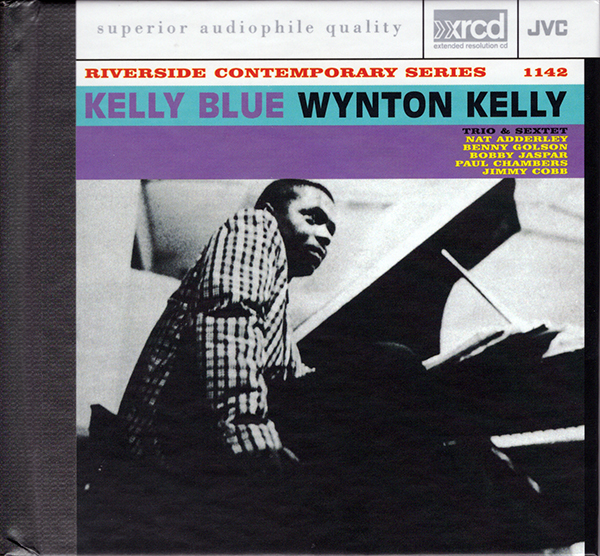
Wynton Kelly Trio and Sextet, Kelly Blue, Riverside/JVC, CD.
This is a gem of jazz/hard bop CD that I haven’t pulled out in a good while. Listening to this in my studio with just the Perlisten S7t towers alone, from the first plucked bass notes of the title track “Kelly Blue” I knew I was in for something special. For an album recorded in 1959, it has an immense soundstage with a great sense of depth that the S7t towers were all too eager to flaunt. That bass, in the hands of Paul Chambers, had loads of string detail that I could clearly hear as he worked and coaxed the notes from his instrument. A real “wow” moment happened when flutist Bobby Jasper comes in on the left side and Nat Adderly’s coronet emerges from the right. As the two are playing together for a bit, the imaging and tonality of their respective instruments while working in unison was just a lovely thing to experience coming from these speakers. I could hear Jasper’s breathing on several occasions as he was playing solo on the flute, and even when his playing reached the loudest of peaks, the Perlisten speakers remained fully composed and unruffled by the additional energy demands on the tweeter. Then there was Benny Golson’s tenor saxophone solo which sounded positively sublime through these speakers. Not only because of the nuances of the instrument that the S7t are so good at relaying but also, in this case, the reverb and ambient sound of the recording space were translated so well to my ears. Moving from the sextet performing this song to the trio playing “Willow Weep for Me”, the performance gets more intimate but no less enjoyable. I felt a palpable sense of depth on this track. Acoustic bass, drums, and piano were so harmoniously imaged that I felt like I was in the recording space. Again, for the age of this recording, Kelly’s piano playing (on the left) had great body to the sound and that classic ring to the notes as they decayed. Chambers was intensely plucking away on the right with the depth and weight of his notes hitting just right. Jimmy Cobb on drums was in the center but pushed farther back in space, the sound of his drum skins and cymbals were more distant but no less clear and crisp. Even when listening casually to this CD while well away from the speakers, at my computer desk, what I was hearing often sounded so good that I had to stop what I was doing to turn around and just enjoy the music.

Brian Bromberg, Wood, King International, SACD.
Since recently getting a recommendation from Paul Barton of PSB Speakers to check out Brian Bromberg’s bass playing I have been diligently going through his back catalog. Wood is one of my favorites of Bromberg’s albums thus far. In this recording, he is playing a 300-year-old Italian upright bass and the tone he can pull out of it is to die for. The introductory bass solo to “The Saga of Harrison Crabfeathers” is just outstanding with the Perlisten S7t reproducing the speed and ferociousness of Bromberg’s plucking, tapping, and harmonics with tangible dimension and impact. I could literally feel the lowest growl from that acoustic bass in my gut at times. But it’s not just all about “da” bass, the accompanying piano and drums also sounded spatially rich and tonally appealing. Nice clarity to the ring and decay from the piano notes while the cymbals of the drums had that nice metallic sheen to their sound. Bromberg’s cover of the Beatles’ “Come Together” is a tour de force. Performed solely by him on the bass, Bromberg is eliciting all sorts of sounds from his instrument well beyond simply working the strings via, tapping, slapping and who knows what else to the outside of his bass. The S7t tower effectively reproduced the intensity of this maniacal playing technique as I could clearly make out the sound and reverberation of his hand slapping his bass in various locations along with the tone and texture of alternating tapping, knocking, rapping, etc. This track is not so much about just playing bass notes but more using a collage of sounds, obtained from a single instrument, to build a melody. The Perlisten S7t successfully renders the detail, intensity, and variety of tones that Brain Bromberg is using to play that song in spades.

Ghost Rider, Make Us Stronger, Dreamstate Records, 16/44.1 FLAC via Tidal.
While I did say that the Perlisten S7t did not need a subwoofer, that didn’t stop me from adding both the D212s subwoofers to the towers while in my studio (insert maniacal laugh here), tying and blending them all together with my Anthem STR preamplifier/power amp combo and ARC room correction. I guess I wanted to see just how much of that “lily I could gild” so after calibration, setting ARC to bass manage everything at 80 Hz, and maxing out the room correction at 350 Hz, I loaded up this track of electronic music to see how much this recklessly over-the-top 2.2 channel system could energize my room. OH. MY. G…..Astounding bass! I have never had so much fun with a stereo system in my house before! If I thought the S7t towers were dynamic sounding on their own, once relieved of having to reproduce anything below 80 Hz, they were even more explosive. The song starts off with higher frequency synthesized notes, ping-ponging from left to right, in front of me and around me which the S7t nicely rendered at various depths of space. Then a processed male vocal comes in from both the left and right channels giving the impression of being spoken to by a large ethereal being, convincingly done I might add. And then…the bass. An almost punishing and concussive bass line begins that carries through most of the rest of the song. I have never felt a pair of subwoofers energize and pressurize this big room the way those D212s subs did on this track. The successive hits to the chest of deep, solid bass notes had me laughing out loud. This was so much fun! There was not a hint of bloat or sloppiness to the bass at all, just relentless, unending pressure that did not overpower what the towers were doing. Turning this track up as loud as I dared, I had the entire room shaking, I was physically taking a beating and the subwoofers looked like they were still just loafing along. If Perlisten’s claims of 60 mm peak-to-peak driver travel are to be believed, then the D212s looked like they had a lot more left in the tank to give. As of this moment, you could not wipe the smile off my face!

Jeff Beck’s Rock n’ Roll Party Honoring Les Paul, Eagle Vision, Blu-Ray, DTS-Master Audio.
Turning now to some home theater listening, I love this disc because the music is just contagiously good, and it captures the acoustics of a typical small club space so well. The Perlisten speakers recreated that ambiance and highly charged atmosphere perfectly. The details and tone of Jeff Beck’s guitar playing came across so clearly from the center channel speaker particularly on the track “Poor Boy” where he’s playing with a glass slide. A glass slide has an unmistakable sound to it as it moves up and down the guitar strings and the S7c got it exactly right. And about that center channel speaker, it handled Imelda May’s vocals with aplomb, reproducing her singing with great body and clarity. Tons of presence and intensity from Ms. May on “My Baby Left Me” and especially on her rendition of “Walking in The Sand.” The effect of her pre-recorded double vocals to simulate what Mary Ford used to do when singing with Les Paul on several songs including “Bye-Bye Blues” and “Tiger Rag” sounded especially good! The speakers were detailed enough that I could make out both her live and pre-recorded vocals whereas with some other speakers the two are more blurred together. The Perlisten speaker ensemble created a seamless bubble that made me feel like I was sitting at one of the tables near the stage experiencing this great concert. The subs again were just outstanding, giving tremendous weight and punch to the stand-up bass and drums, really simulating the intensities as you would hear them in a live club like this, check out “Casting My Spell on You”. Incredibly good!

The Tomorrow War, Streamed via Amazon Prime, Dolby ATMOS.
A science fiction, time travel story with an incredible and immersive sound design. Chris Pratt, along with several other members of humanity are sent to the future, in what appears a hopeless attempt, to stop an alien invasion of earth. One intense and memorable scene with Chris Pratt’s team escaping down a building stairwell while being chased by the alien creatures known as “White Spikes” was just a textbook example of object-based overhead and lateral effects flying everywhere merged with non-stop bass impacts from gunshots, explosions, and all manner of explosive effects. It was impressive sounding and utterly convincing. And that was just within the first half-hour of the movie! The Perlisten speakers projected a perfect sonic envelope that kept the intensity of the action coming wave after wave. In any scene where the alien White Spikes massed for an attack, I could hear their wailing and eerie clicking sounds moving all around me, cleanly and clearly, from channel to channel. The twin D212 subwoofers made sure that any bass content was felt as well as heard. Whether, from gunfire, explosions, or helicopter rotors, we could feel the bass pressurizing the room and us in the bargain.
Measurements by Carlo Lo Raso, Technical Analysis by Carlo Lo Raso and David A. Rich.
Bench tests were performed with a Cross Spectrum Labs calibrated UMIK-1 USB microphone connected to my Surface 3 PRO tablet and using Room EQ Wizard acoustic measurement software. On and off-axis measurements were taken with the mic at 1-meter from the center point of the tweeter as the 0-degree reference point. Unlike measurements taken outdoors or in an anechoic chamber that measure a speaker in isolation (and assess straight-line engineering), in-room measurements give a sense of how a speaker behaves in the actual environment that it’s used. Both types of measurements are valuable, I just find in-room measurements interesting as they help shed light on what I am hearing and why. That and I don’t own an anechoic chamber!
Impedance measurements were taken using the Dayton Audio DATS v3 loudspeaker tester and software.
To keep the review manageable, I focused my testing on the S7t tower speakers as they are the ultimate execution of the technologies contained in all the other Perlisten speakers in the system.
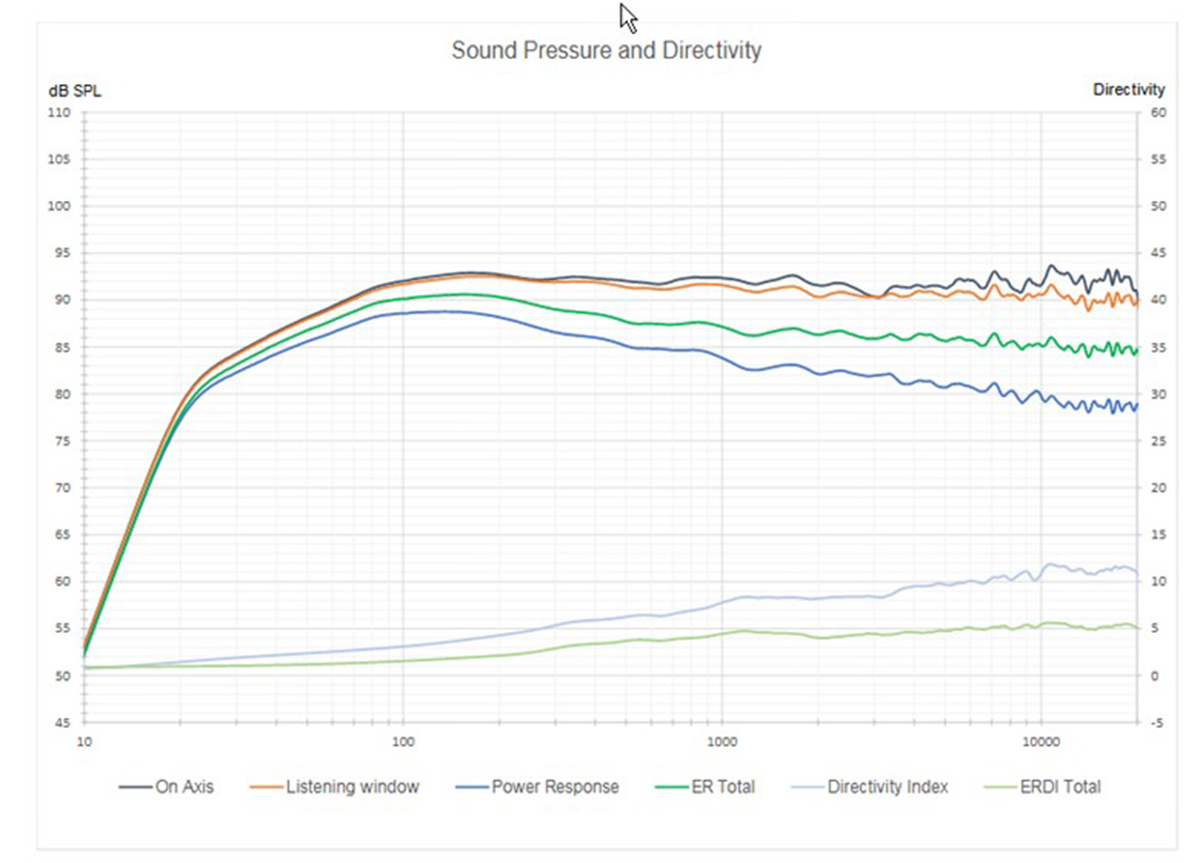
Perlisten S7t, Anechoic CEA-2034 response curves, from Manufacturer
Before we move to our measurements let’s looks at the anechoic CEA-2034 response curves supplied by Perlisten. These were made outdoors with the speaker on very high stands to attenuate floor reflections. The low-frequency response is likely a ground plane measurement spliced in.
David Rich notes: In these results supplied by Perlisten, the early reflection response is marked ER Total. ERDI Total is the early reflections directivity index.
These look excellent but one must understand that degrees of freedom exist that will make one speaker with a close to ideal set of CEA-2034 curves sound different from another. This is in the DI (Directivity Index) curves. Different speakers will produce stronger early reflections back to the ears than others. The same applies to the power response. Even if the DI is monotonic and close to linear like the ones shown above, the level of these curves will differ between speakers.
Changes in DI ratios will obviously set the tilt of the in-room response and no ideal tilt value exists. It depends on the listener. The other factor is the sound stage width, or some would say the spaciousness of the sound in mono. Reduced reflections will create a speaker with less envelopment since more direct sound is coming to the ear.
Note that HARMAN CEA-2034 curves do not have the right-hand Y-axis with the DI values like Perlisten supplied. It is easy to calculate. Find a low frequency with all the response curves at the same value. Now go to the DI curves. At that frequency the DI is 0dB. You can see this occurs around 20 Hz in the Perlisten S7t data.
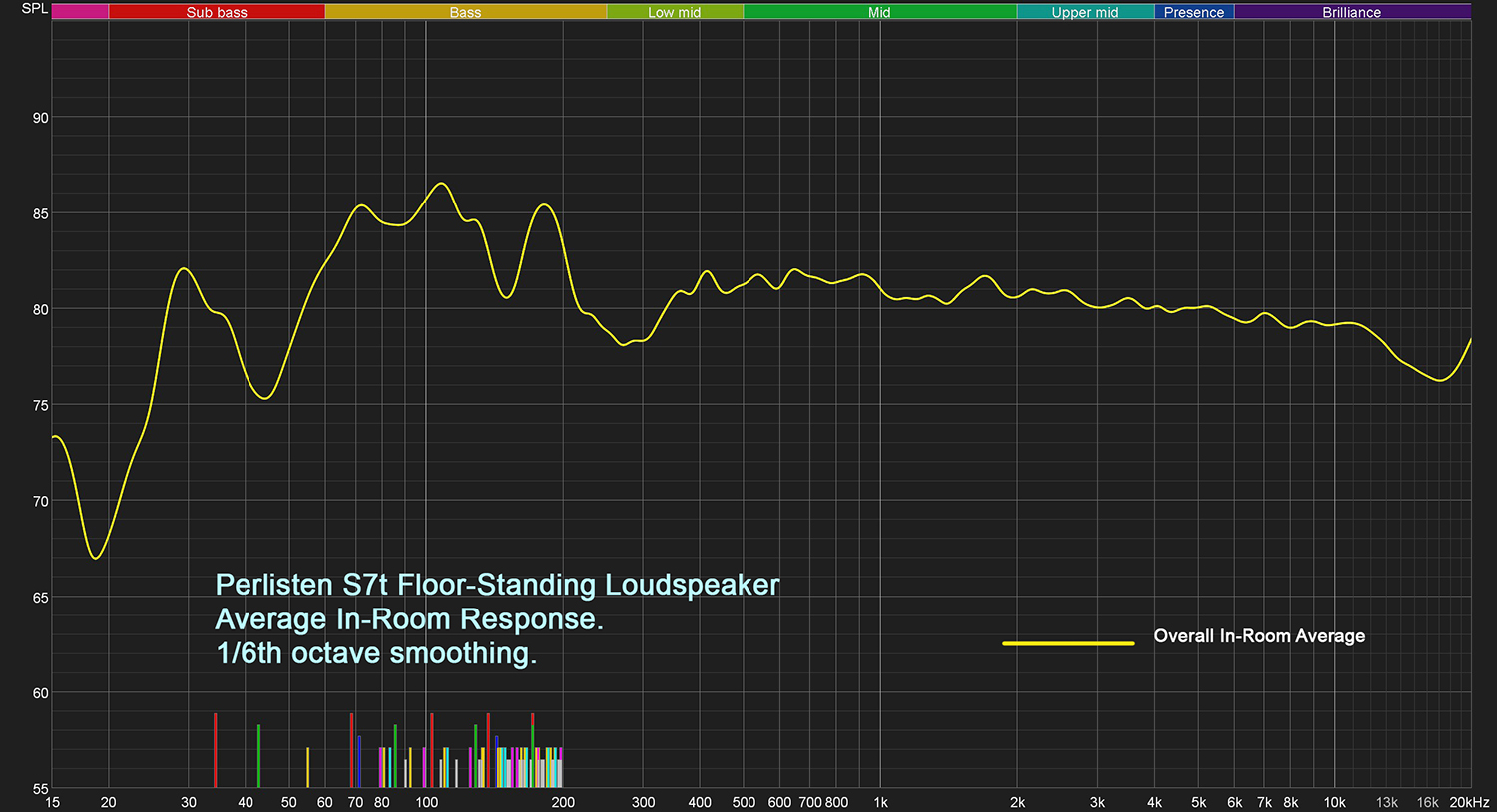
Perlisten S7t, Averaged In-Room Response, No Room Correction
This in-room measurement of the Perlisten S7t tower speaker is an 18-point spatial average. A 9-point measurement was made for the right speaker and then repeated for the left speaker. Averaging both speakers is an approach that others have been using and publishing. Using data from both speakers reduces the modal response of the room by averaging the differences in the response of the two speakers from room asymmetries. The technique cannot eliminate them however and, as such, the response below 300Hz remains room dominated. The results show an admirably smooth and gently declining response between 350 Hz to 20 kHz. This is one of the smoothest natural room responses that I have seen, through this bandwidth, from any speaker that I have had in my room. Below 350 Hz, we see more of the room exercising its will with a bit of a trough in the response to 200 Hz. The narrow, sharp dip at 160 Hz is most likely a floor bounce (the distance from the woofer to the floor and back to the speaker) which appears in all my speaker measurements in this room. Bass response is otherwise strong to 70 Hz below which we have a steep drop at 45 Hz, then shooting up to a lower peak at 29 Hz and rolling off after that.
David Rich notes: It is useful to compare this result to speakers we previously reviewed. The Perlisten response shows less variation above 400Hz. It looks very close to the target curve preferred by listeners in a double-blind comparison test. It shows a slow decrease in amplitude with frequency. This response is a mix of the direct, early reflections from each wall, floor, and ceiling and power response which consists of multiple bounce reflections coming back to the listener’s ear. The room contains absorbent material which attenuates the amplitude of the reflections with increasing frequency. If the speaker’s radiation pattern matches the direct response and the direct response is flat, the curve we see above is the expected result.
One needs to understand this one curve does not tell us fully how well the speaker performs. We need to look at the quasi-anechoic curves below to see the components that make up the direct response and the reflections.
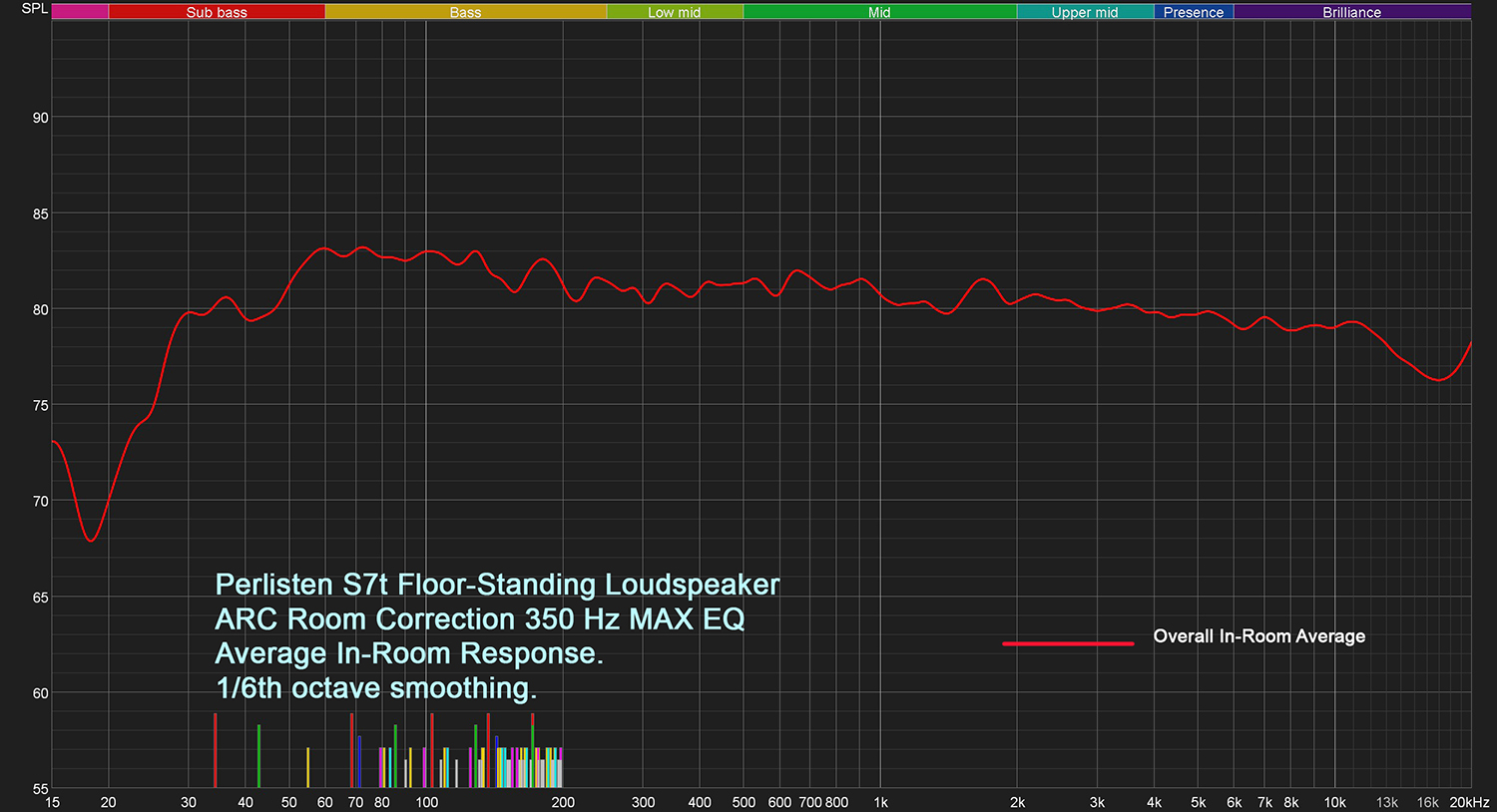
Perlisten S7t, Averaged In-Room Response with ARC, MAX 350 EQ
This graph shows another averaged in-room response of the Perlisten S7t, performed in the same manner, but using Anthem’s ARC Genesis room correction to correct room issues from 350 Hz and below. Everything above 350 Hz is untouched. We see that the bass region, while strong if a little peaky in the previous graph, has been evened out here to match the higher-end response.
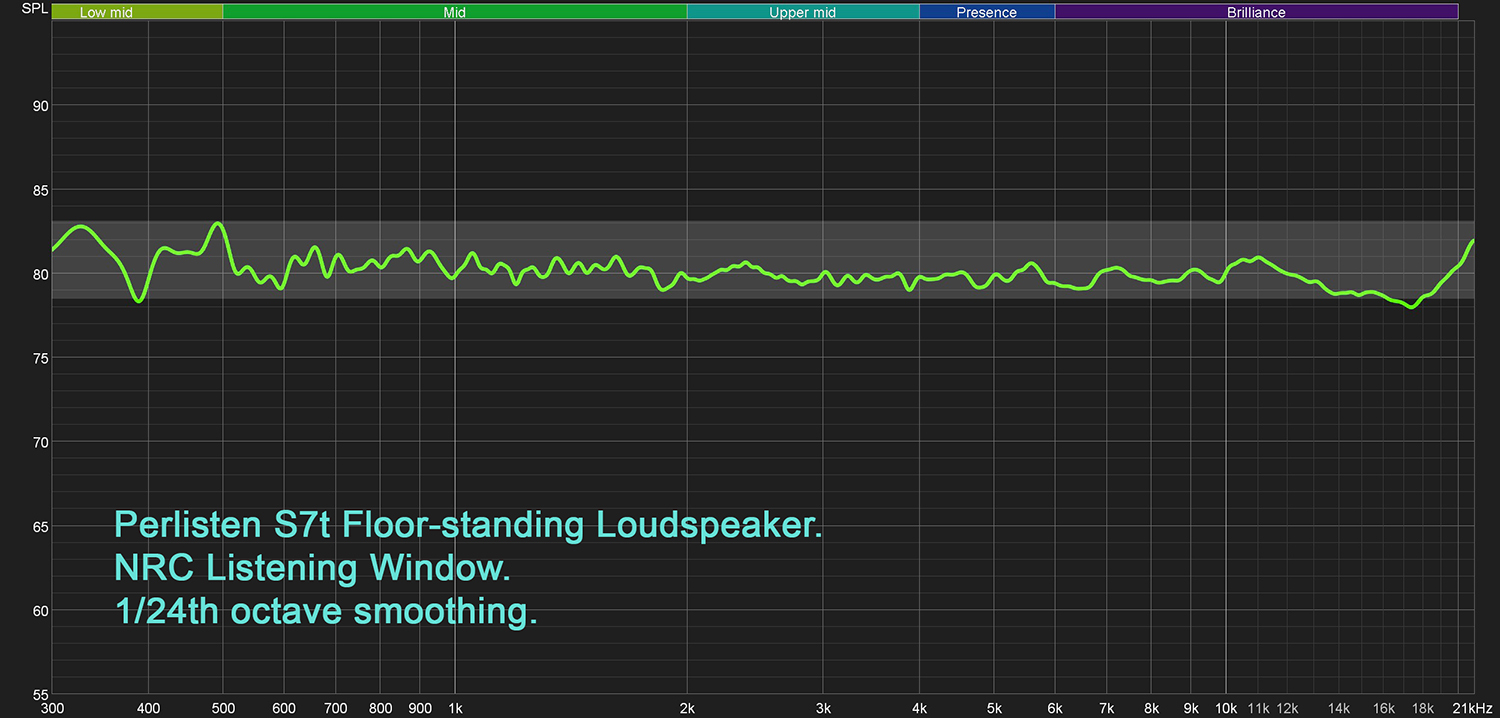
Perlisten S7t, NRC Listening Window Response
This is a plot of the NRC listening window for the Perlisten S7t scaled from 300 Hz on up which is averaged from the following measurements: 0-degree on-axis, +-15-degrees vertical, and +-15-degrees horizontal. In this portion of the frequency range that is dominated by the speaker (response below 300 Hz tends to be dominated by the room and can vary greatly), we see a superbly controlled and uniform response pretty much up to 20 kHz. Even with only 1/24th octave smoothing, almost the entire listening window fits within +/- 2.5 dB span.
David Rich notes: Carlo is being stingy here. Response from 500Hz to 12kHz fits in a +/- 1.5dB span. Look back at the curves Perlisten produced. Not much different. How come our data is looking so much more accurate relative to the manufacturer’s curves in this measurement than we have achieved for other speakers?
Our measurements are done in Carlo’s basement studio. Not on a huge scaffold tower built outside the house. Room reflections thus get into the measurement, especially from the floor and ceiling. We try to window most of this out, but the floor and ceiling reflections typically come back so soon in time that we would normally have poor measurement resolution below 1kHz. With the Perlisten S7t, I noticed the floor and ceiling reflection were much smaller than data from other speakers recently measured (not shown). The greatly reduced reflections significantly improved the accuracy of our measurements. We will see why this happened below.
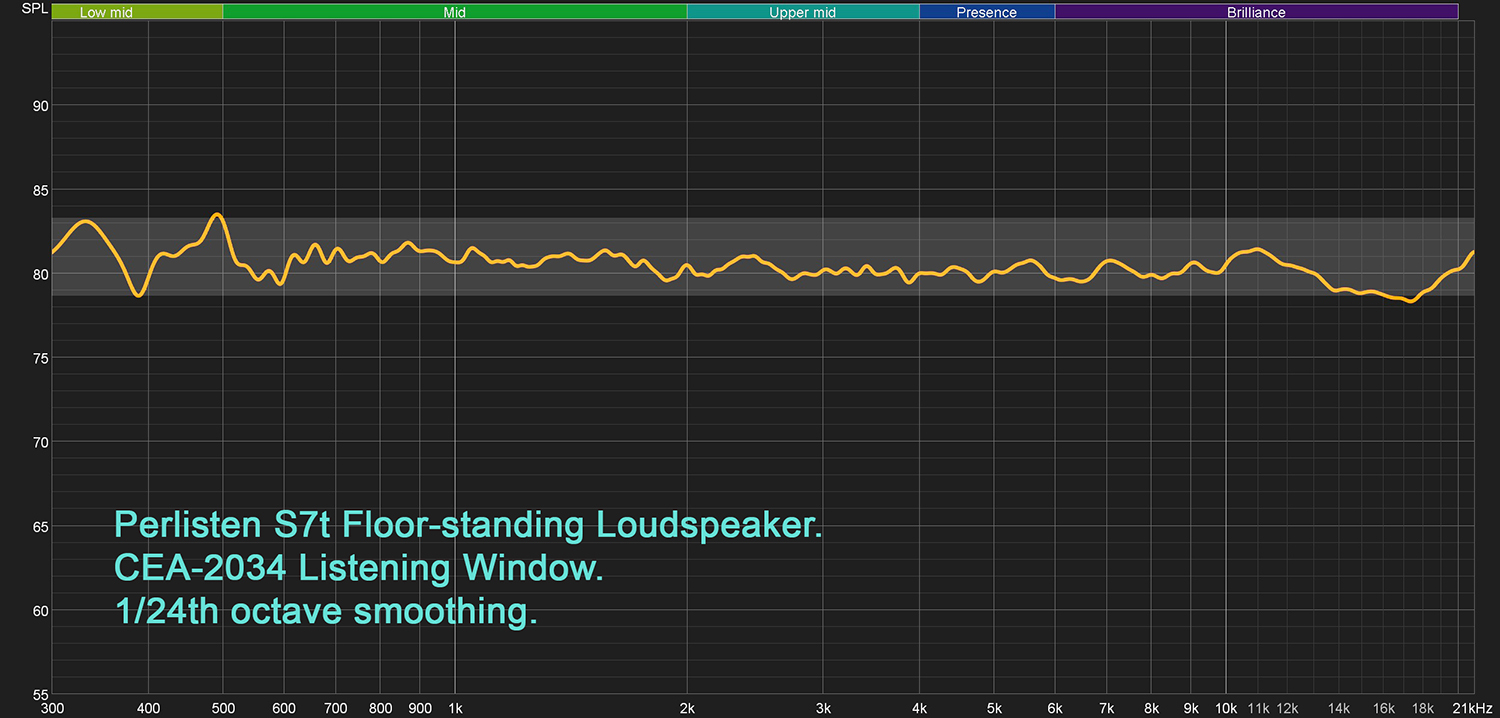
Perlisten S7t, CEA-2034 Listening Window Response
To compare, this is a plot of the CEA-2034 listening window for the Perlisten S7t scaled from 300 Hz on up which is averaged from the following measurements: 0-degree on-axis, +/-10-degrees vertical, and +/-10 and +/-20-degrees horizontal. Here, with the same 1/24th octave smoothing, we see an almost identically smooth listening window as in the NRC example.
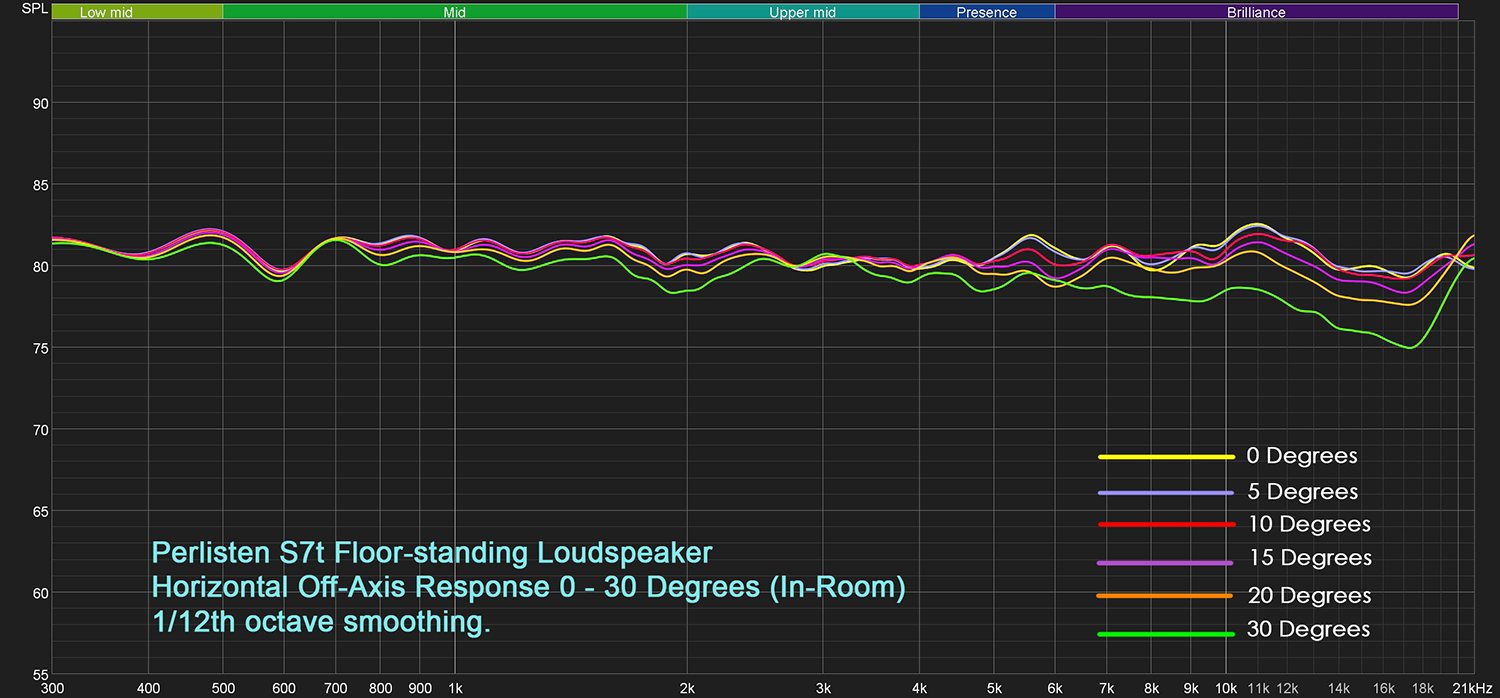
Perlisten S7t, Horizontals 0-30 Degrees
Above are the horizontal radiation curves of the Perlisten S7t from 0 to 30 degrees, scaled from 300 Hz on up. Looking at the angles most closely related to the direct response we see smooth curves with no obvious resonances at the 1/12th octave smoothing used here.

Perlisten S7t, Horizontals 45-90 Degrees
Above are the horizontal radiation curves from 45 to 90 degrees, scaled from 300 Hz on up. Again, we continue to see generally the expected rate of extended off-axis decline. The unevenness between 2 kHz to 3.5 kHz is more visible the farther off-axis we go.
David Rich notes: We are seeing some non-monotonic behavior at wider angles in the 2 kHz – 3.5 kHz range. Dan Roemer, the CEO and head of engineering, told us he could clean this up with a change in the waveguide, but it would not improve the directivity indexes since he would have to trade the vertical radiation response characteristics, which as we are about to see, is what makes this speaker different.
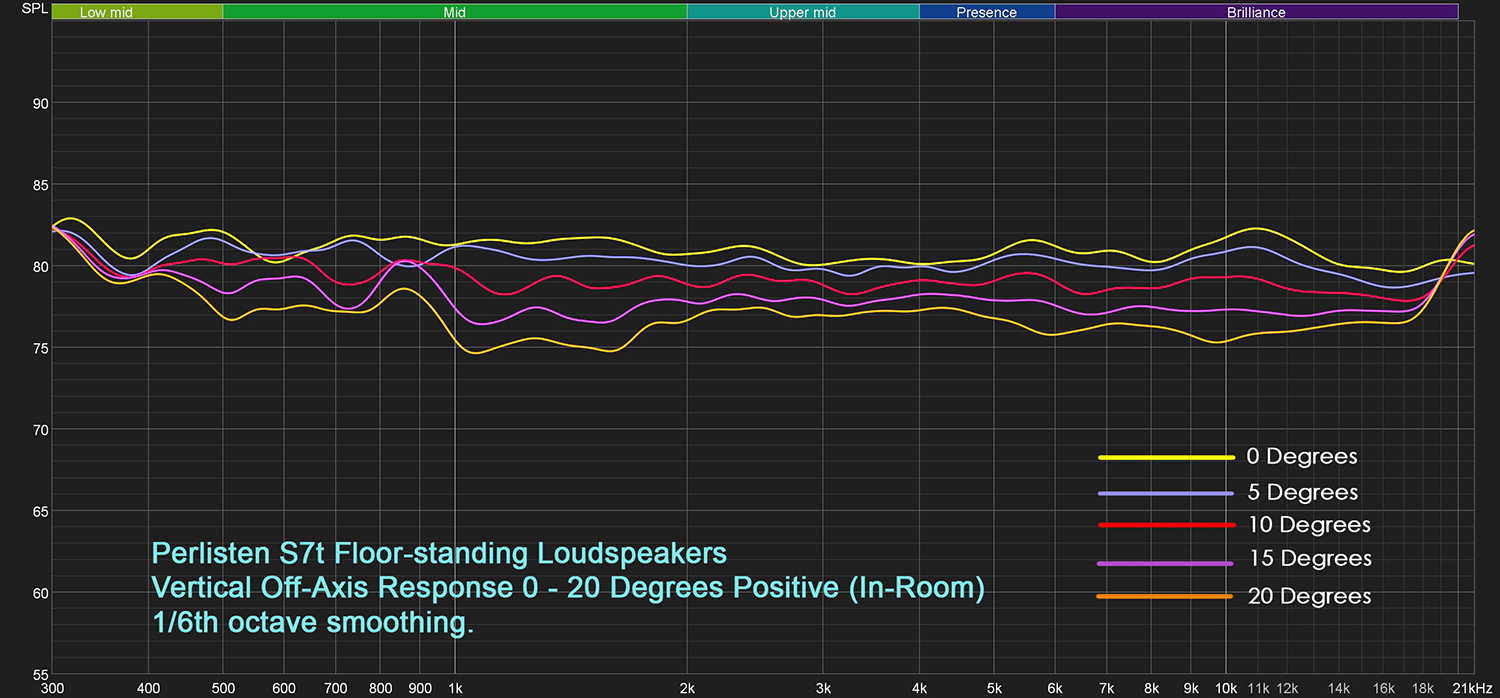
Perlisten S7t, Verticals Positive 0-20 Degrees
Moving to the vertical radiation pattern for positive angles for the Perlisten S7t, we see the plots for 0 to +20 degrees, scaled from 300 Hz on up. Overall, we see exceedingly good, controlled behavior.
David Rich notes: This curve looks very different from what we see in other tower speakers with cones, domes, or ribbon tweeters. With the increasing angle, the response drops at about 500 Hz then holds approximately flat. This controlled radiation pattern is the result of what Perlisten calls the Directivity Pattern Control array and associated crossover. It is more than the 3 domes doing this since the controlled response goes down to 500 Hz. The inner pair of woofers are also contributing coupled with the crossover characteristic feeding those inner woofers. Perlisten makes it a little confusing with their focus on the Directivity Pattern Control because what we are seeing in this graph is the result of a lot more engineering than just what’s in that central structure. Perlisten shows the radiation pattern in its literature but for some reason limits it to 1 kHz. It’s impressive but not as impressive as our curves which extend down more than an octave more.
So, the vertical radiation pattern is very different but what positives does it bring? Controlling the vertical radiation pattern reduces the floor and ceiling bounces. Does it really do that well enough to make a difference for the listener? Look back at our quasi-anechoic listening window and in-room frequency response curves. The vertical radiation pattern you see here is making a rather dramatic difference. Note, once attenuated at 500 Hz the curves stay constant. While the bounces are attenuated, they are not gone, and the curves need to be well controlled as we see here to prevent the directivity indices from being degraded.
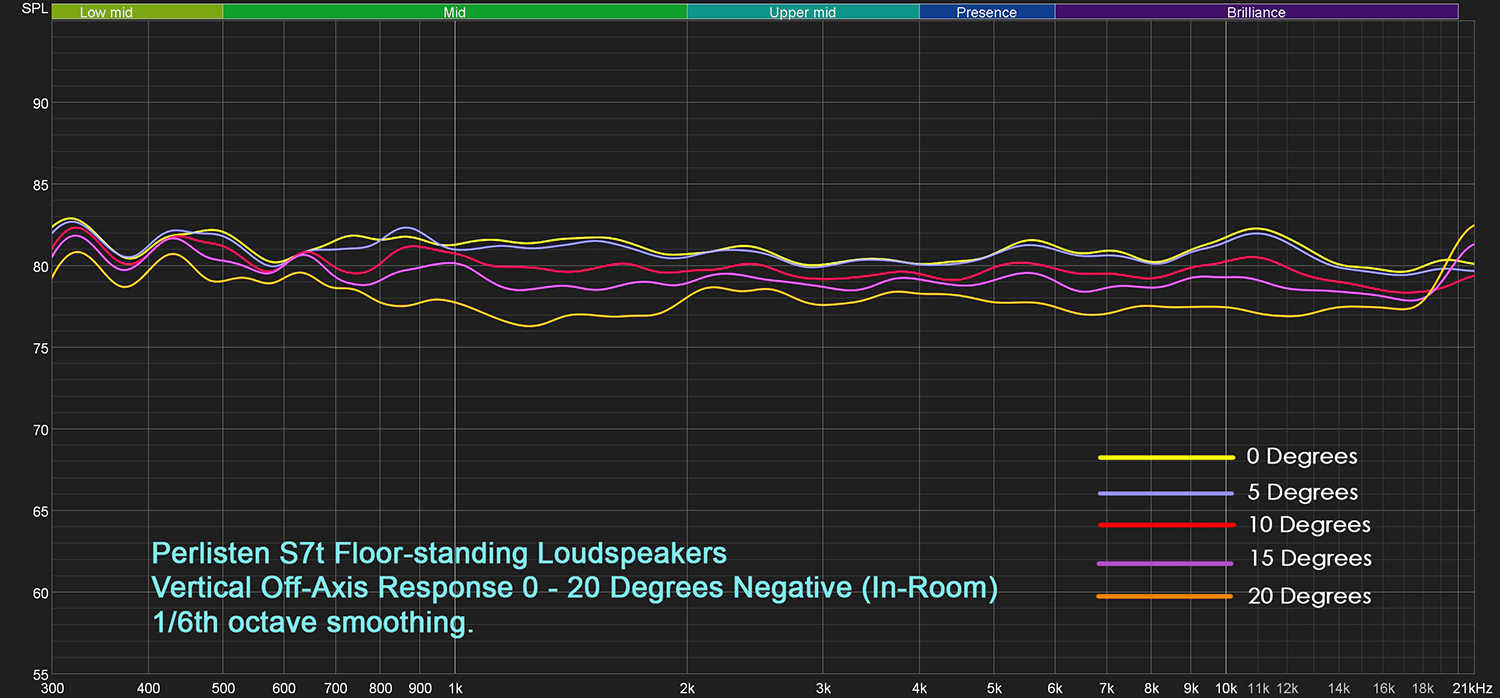
Perlisten S7t, Verticals Negative 0-20 Degrees
In the vertical radiation pattern for negative angles for the Perlisten S7t, we see the plots for 0 to -20 degrees, scaled from 300 Hz on up. You can see the curves are symmetrical to the positive vertical radiation patterns. Given the speaker is fully symmetrical about its vertical axis, this is an expected result. Since these are negative angles the floor bounce is being attenuated here.
David Rich notes: Is it a free lunch? No, sorry, you do pay for this. The speaker is more sensitive to the listener’s ear height. The same technology that limits the floor and ceiling reflections prevents optimal response for those of you who like to stand in front of the speaker, score on a music stand, and play conductor (Okay, maybe only I do this).
Can this problem be solved? Yes, but only with DSP and an amplifier for each driver. Then the response could be optimized for different listening heights, but this would start to excite the ceiling reflections. No question a DSP version of this speaker would allow the engineers to make many other improvements. We are back to the “active speakers are better but never sell in the USA” issue. What I am describing would be more expensive than a typical DSP based active speaker since the inner woofers and three dome speakers need an amplifier, DAC, and significantly more DSP computational power, but the passive crossover in this speaker is far from cheap and dumb given its complexity and the parts cost of those air-core inductors and film capacitors.
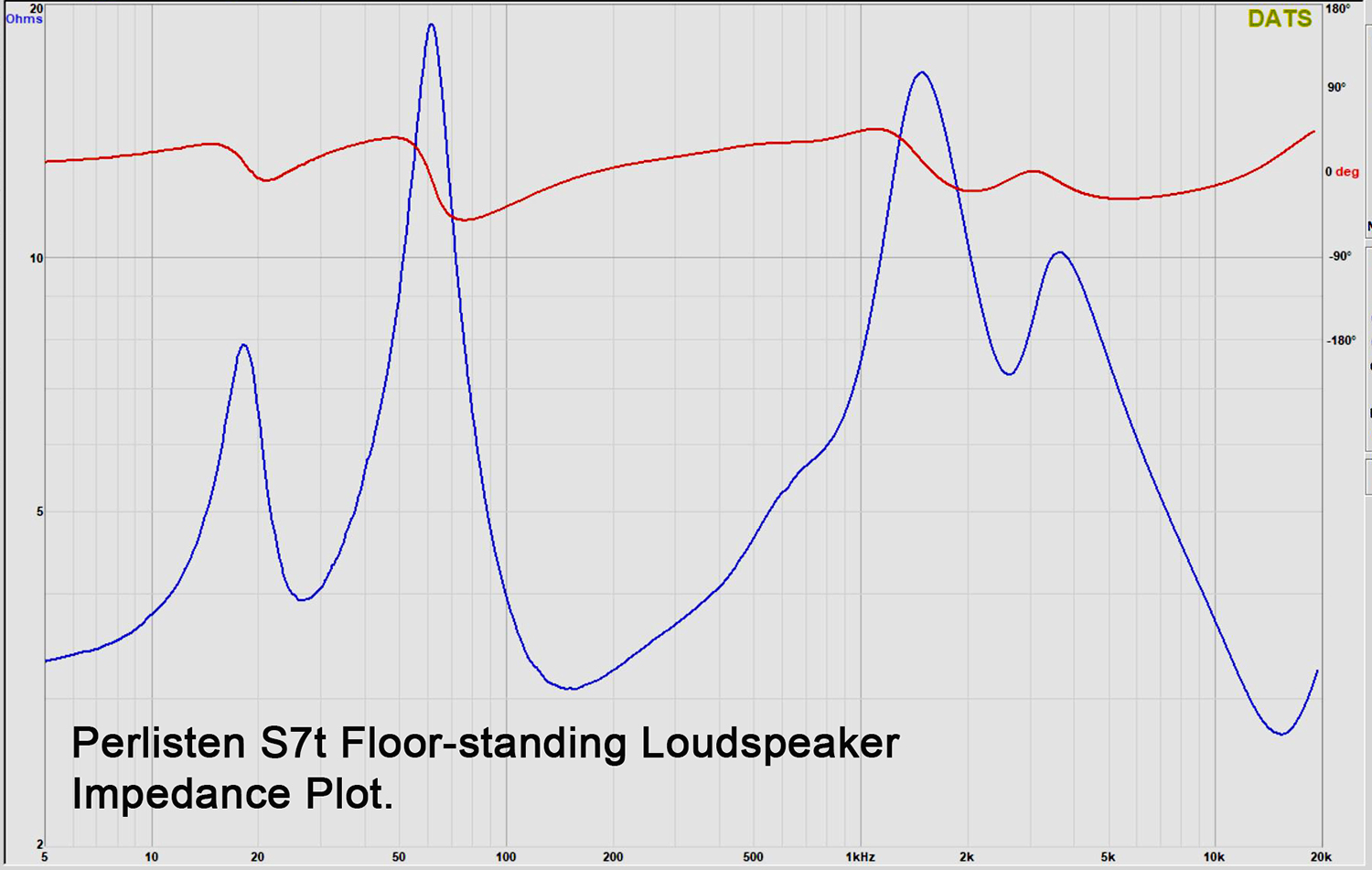
Perlisten S7t, Impedance Sweep
Here we have the Impedance sweep for the Perlisten S7t. Results show much of the speaker’s operating range takes place between 3 to 5 ohms. Bandwidths of 40 Hz to 90 Hz and 600 Hz to 7 kHz happen well above 5 ohms. So AVRs like my Anthem MRX1120 and comparable should be able to drive these just fine, but more good quality power is always better if you can get it.
David Rich notes: I say spend the money on the speaker. Forget the expensive shiny amps. The Anthem also supplies the room correction needed to create the state-of-the-art in-room response. So there!
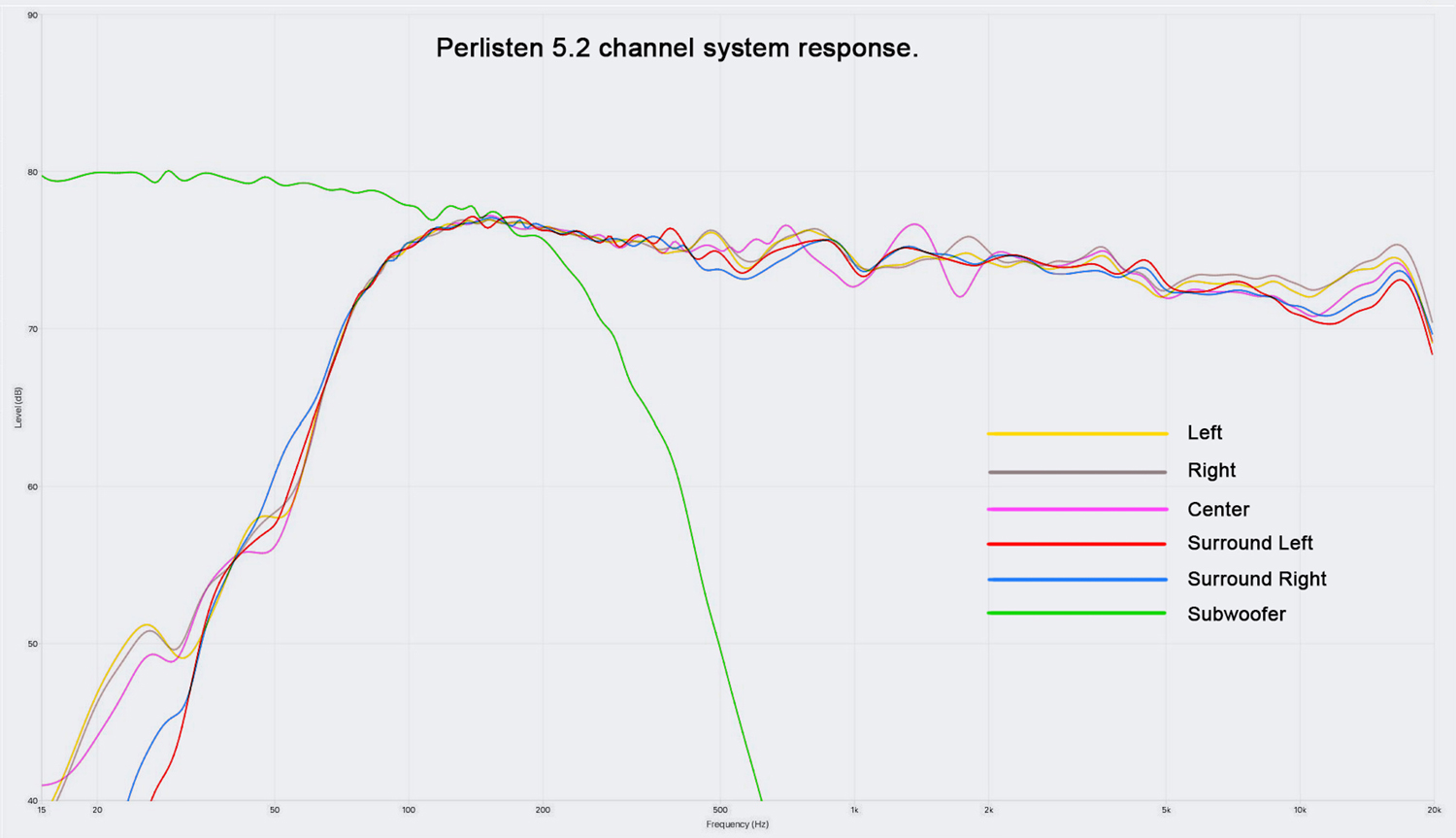
Responses of Perlisten speakers and subwoofers in the home theater
This is a graph from Anthem ARC showing the calibrated responses of all five Perlisten speakers and the dual subwoofers (summed response) in my home theater. The Left and Right channels had a MAX EQ level of 350 Hz, the Center channel MAX EQ was 700 Hz while the surrounds had a MAX EQ level of 400 Hz. The subwoofers blended into the space very well and had solid extension to at least 15 Hz.
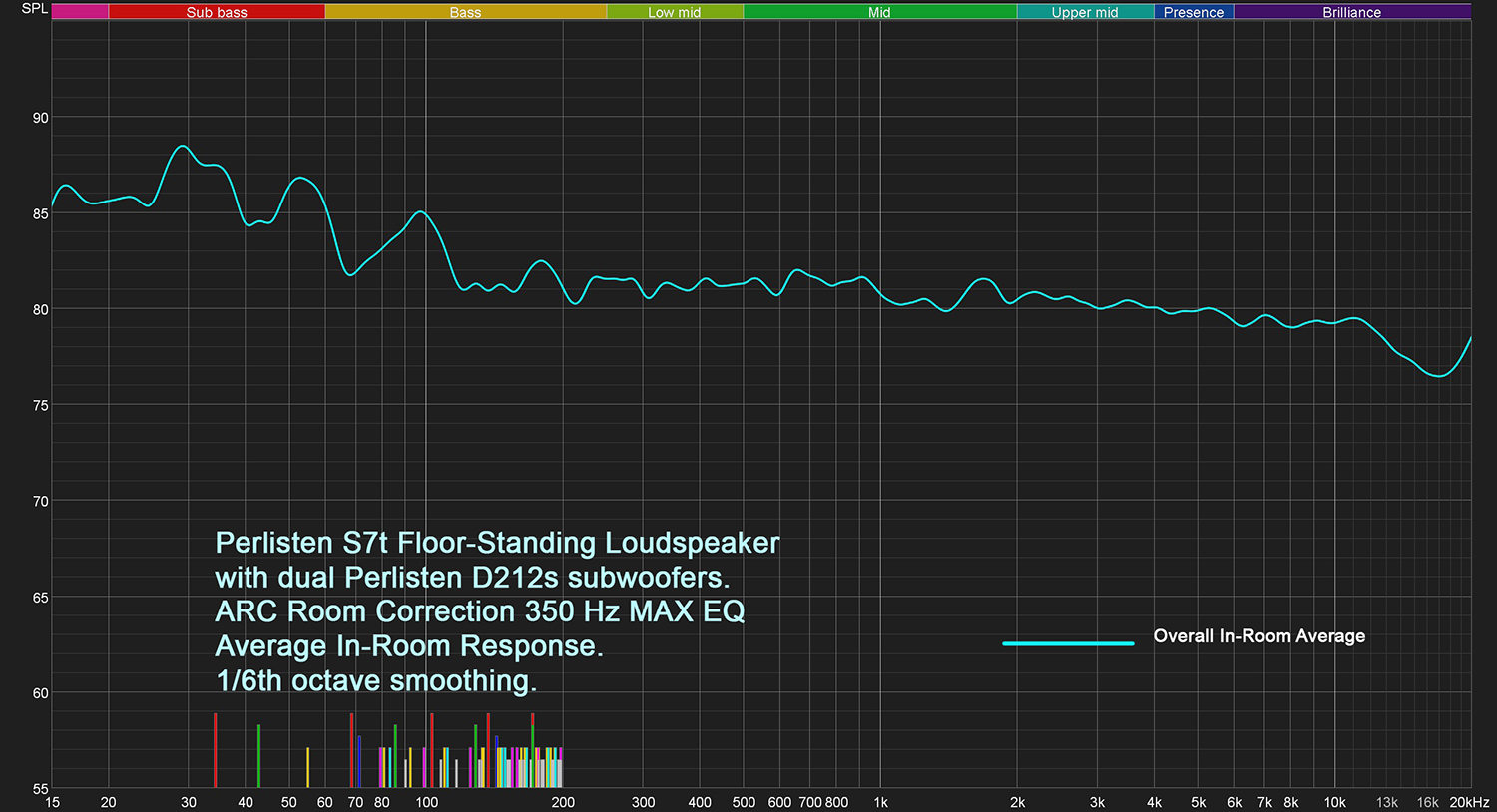
Perlisten S7t and dual D212s subwoofers, Averaged In-Room Response with ARC, MAX 350 EQ
And just for fun, this is an average in-room response taken of the Perlisten S7t loudspeakers with the twin D212s subwoofers as a 2.2 channel configuration in my large studio space. As a point of reference, many dual subwoofers that I’ve had in this room would lose steam just before 20 Hz as there is a room mode at about that frequency that usually causes a big suck-out in the response. The dual D212s, whether due to their design, sheer output level, or both, maintained a full and solid response down to at least 15 Hz in this big room. Impressive.
David A. Rich Design Comments:
To conclude the measurement section, this speaker is a significant advance on what has been about 25 years of evolution of the 3-way speaker with a vertical array of a dome tweeter, cone midrange, and woofer. The use of computer-aided design tools was essential in these speaker’s development. The advances across the past 25 years have been documented in both AES papers and an examination of the finished product.
We do not have any public-facing documentation of the Perlisten S7t although we will when the patent applications are eventually disclosed. What we do have are the measurements the speaker produces. That this is an advance on current speaker designs can be seen specifically in the vertical response, but its effect may be better appreciated with our results in the listening window and in-room response. I do caution that the intellectual property that enables this speaker does not, on its own, set the sound of the speaker. Changes in the slope of the in-room response and the value of the directivity indexes will change the perceived frequency balance and spaciousness of the speaker playing in mono. Perlisten is setting these to achieve what they think is the optimal subjective result. If others had access to the Perlisten IP they could create a speaker with a similar performance, but enough degrees of freedom exist to create something that sounds a little different in your room. Lucky for me the subjective listening department is in Carlo’s domain although I was excited enough about what I was measuring I had him listen in mono using sort clips of material HARMAN Labs had identified as optimal for evaluating the tonal balance of speakers. The report I got back was the listening tests were not as painful as they might sound, and his positive perception of the speaker had not changed.
It is clear that replacing the passive crossover with DSP would provide even better results and the possibility to control the vertical response to optimize it for listener’s height. Perlisten states that in home theater applications with multiple rows seating, no single optimization will satisfy everybody, and the current design will work well with such seating. Adding DSP to this design that could optimize the main lobe would require an amp on every driver and a DAC connected to every amp. The computational power needed in the DSP would be far greater than what is required when replacing the passive crossovers in a typical 3-way speaker.
What I would really like to see is Perlisten cost reduce this product so more people can afford it. The website indicates a $7000 per pair version is under development now. The preliminary measurements are more than promising but they need independent confirmation.
In summation, a major advance in the science of speaker design has been demonstrated by Perlisten. Bravo.
If you are searching for Best-Bang-for-the-Buck, then please look elsewhere. If you are searching for Best-Bang-That-There-Is, then you should search these Perlisten speakers out immediately and take a listen. Highly recommended for anyone considering an end-game system!
- Precise, dynamic, yet musical reproduction of serious capacity.
- Novel DPC-Array (in all speakers) results in excellent and consistent on and off-axis response.
- Both individually and as a system, the speakers excel at both music and movies.
- D212s subwoofers are incredibly powerful and flexible.
- Unique and attractive design.
- The technology trickle down into something I could afford.
As a new company with interesting products claiming impressive performance, Perlisten is more than just a pleasant surprise. They have come to market with a fully formed product line and production pipeline and the speaker and subwoofer models they provided me for review are simply superlative. While aesthetics is the most subjective of things, I found the design and finish of all the products to be extremely appealing. Build quality was also exceptional, solidly put together with a fit and finish that was some of the best I have encountered from Chinese manufacture. The technology incorporated into the speakers and subwoofers, while not completely new, is uniquely applied and leads to quantifiably positive results both by ear and by measurement. And finally, even though the name sounds like the newest Transformer toy, the THX Certified Dominus specification is not merely hype, but a serious set of criteria that these products will deliver on. There is no question that a pair of Perlisten S7t towers could satisfy the most discerning 2-channel listener if given the chance. If that listener is a bit of a sadist, then adding the twin D212s subwoofers can create a 2.2 channel system that would crush all comers in both intensity and finesse.
When used as part of the entire home theater package, as tested here, the results are electrifying, immersive, and completely convincing for both movies and music. I have not experienced better, yet, in my home. The downside? The price of each of these Perlisten speakers and subs put them well out of my, or the average person’s, reach. Make no mistake, it all sounded and looked so good that If I could, I would have kept this entire system. But in my case, outright thievery, divorce, or selling my children into indentured servitude did not seem like viable options. The boys at Perlisten have done something quite special here. Beyond making a measurably and audibly superior set of products, they have very much created serious objects of desire. Wicked, wicked things that make the more obsessive in us entertain unnaturally covetous thoughts. Marketing departments across the land would tag these Perlisten speakers as “exclusive, aspirational products.” That’s far too milquetoast a caption. I say that Perlisten has lightning in a bottle here. Pure unadulterated audio-Everclear. If you have the space, the means, and the wherewithal, let me introduce you to your new home theater system. You will not be sorry, and I will so, so envy you!
The author would like to thank David A. Rich for his invaluable assistance in this review.


